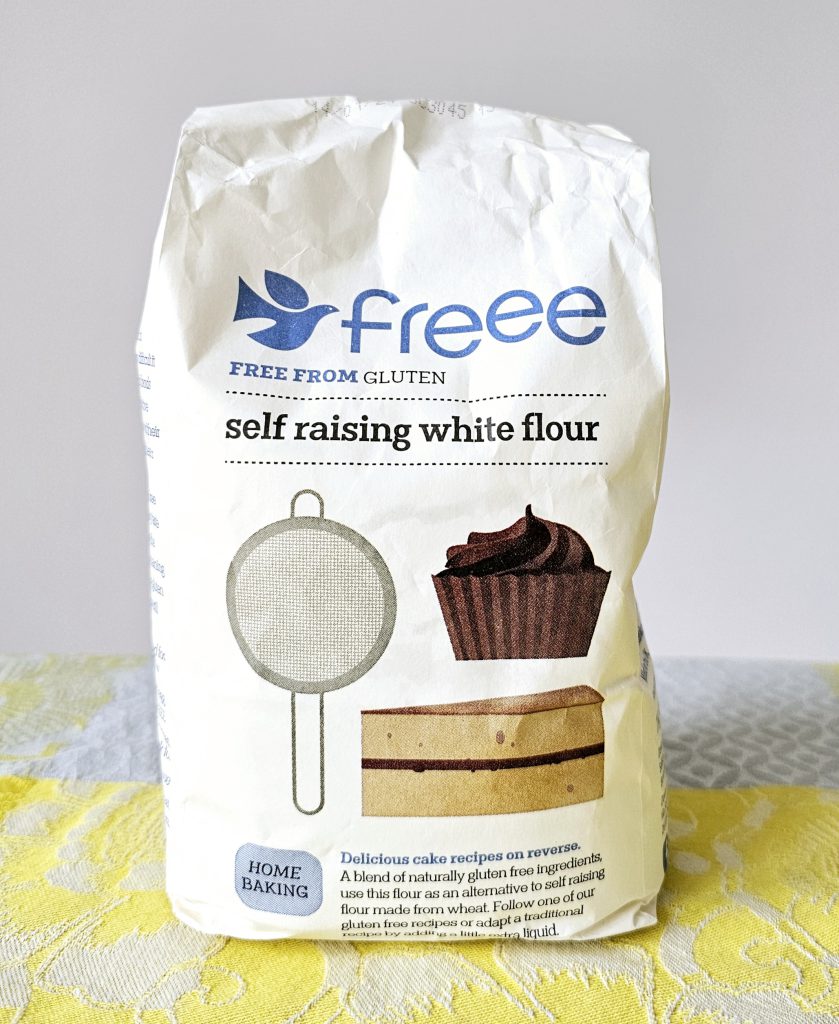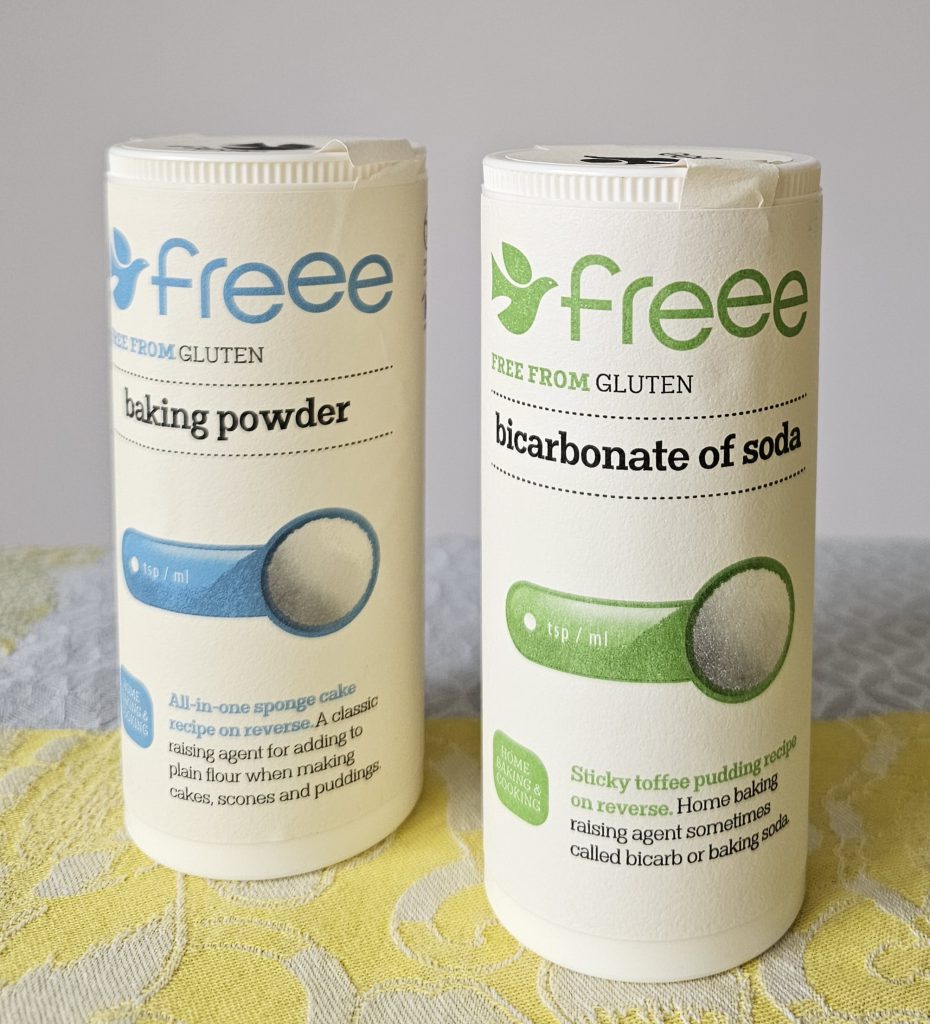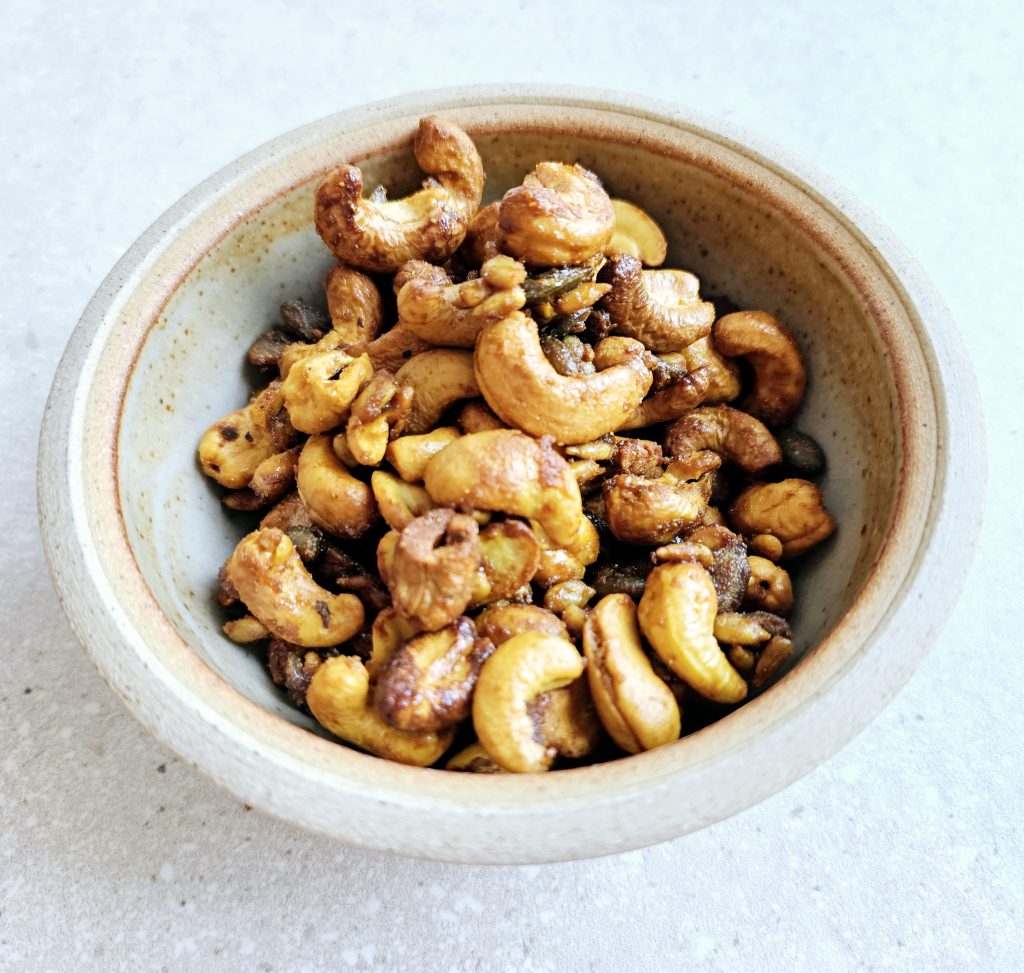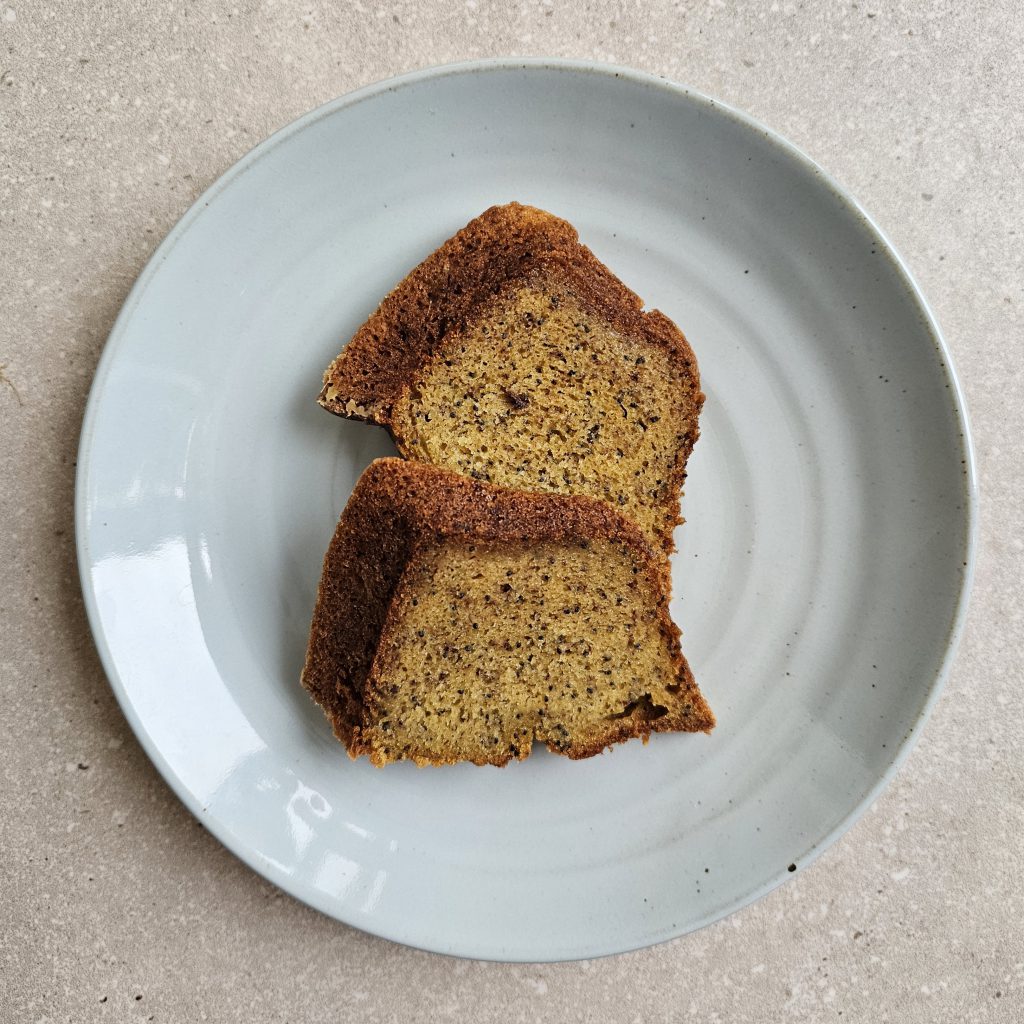
Recipes
Slow-roasted Beetroot with Labneh
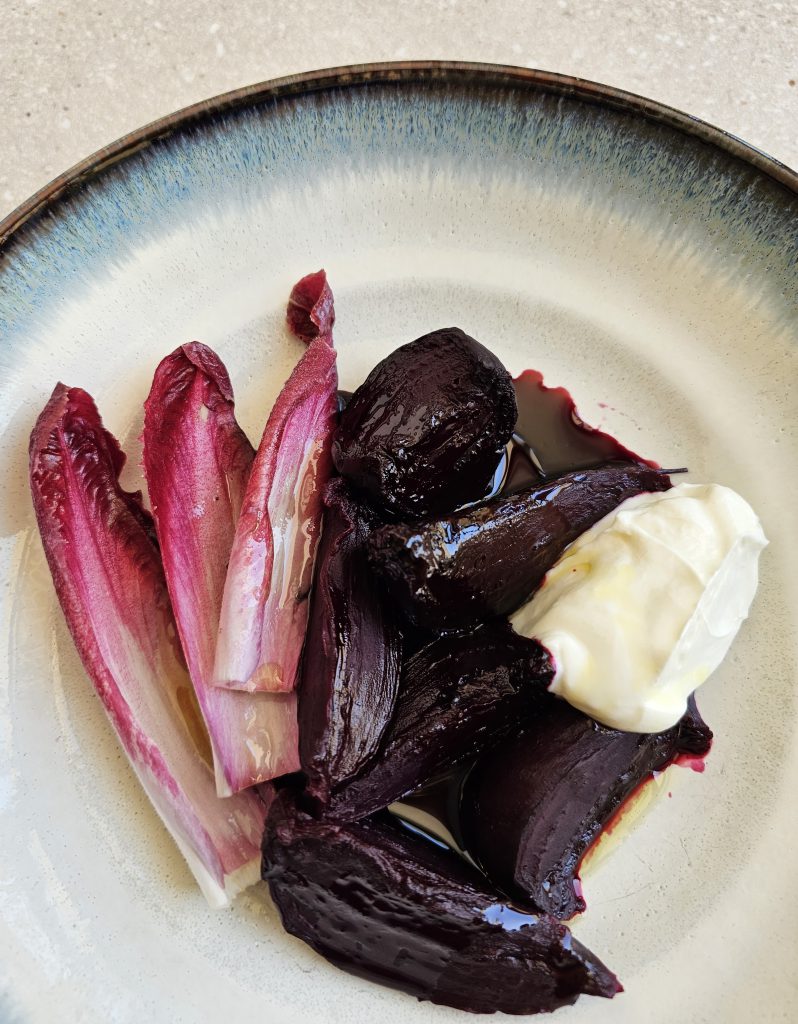
This is the dish I could not stop thinking about during dinner at Otto in Berlin, after I left the restaurant, and as I returned to my kitchen in London. Chef Vadim Otto Ursus’s beetroot, sloe berry, labneh and brown butter is not easy to describe because it is unlike any other dish I have had, beet or otherwise. I attempted to make it using his recipe which I found here.
Otto’s June 2023 menu and the the beetroot dish

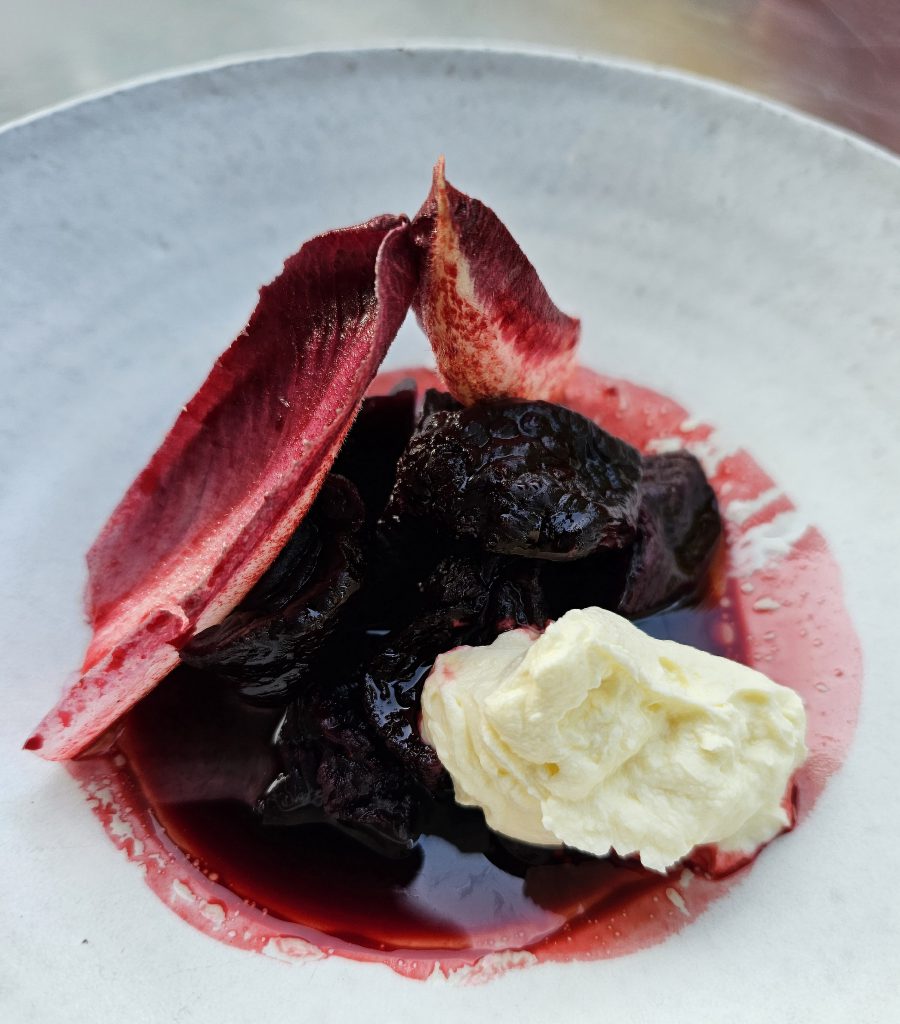
The recipe below has been adapted to suit my own cooking practicalities (I use the oven a lot). For chef Otto’s original recipe please see here.
I could not find any purveyors of sloe berry juice, but research indicates that it is possible to head up the road to Hampstead Heath and pick my own during the right season. Most people would pick sloe berries to add to gin (indeed there was a very popular book published 30 years ago called Sloe Gin and Beeswax which showed you how to make this) but if I were to find any, it would go into making this beetroot dish.
Since sloes are in the same family as plums and cherries, I opted to use tart cherry juice as that was what I could find. I would imagine pure cranberry juice would also make a good substitute.

The dish took two days to make but most of the time it looks after itself: roasting, soaking, dehydrating and then briefly boiled before serving. As it can be prepared ahead of time, it is a perfect addition to the vegetable platters from the other Otto i.e. Ottolenghi, whose dishes I cook every weekend when I have friends and family around the dinner table.
For the Beetroot:
1 kg medium-sized fresh beetroot
2 teaspoons fine sea salt
600 g tart cherry juice
250 g labneh
OR
strain 500 g full-fat sheep / cow yoghurt to make your own labneh
4 tablespoons pomegranate molasses
2 – 4 tablespoons olive oil
a few leaves of Belgian endive, for serving
How to Make:
DAY 1
Top and tail the beetroot, then give them a quick rinse under water if the skin is muddy. Dry with a paper towel then wrap each beet in some foil. Bake in the oven at 200°C / 180°C fan for 50 minutes.
Switch off the oven but leave the beetroot cooking in the residual heat for another 30 minutes. By this time they will be just right, yielding but not too soft.
When the cooked beetroot has cooled a little, remove the skin. When I was about to proceed, Niece Number 2 showed me her super efficient and neat way of doing this: cup the beet, still in its foil, in the palms of both hands. Simply twist the foil, which will act like a ‘scrubber’ to scrape the skin off the beet. The skin literally rubs off in one go and the whole process takes a few seconds.
Cut each beetroot into 6 wedges and place in a large non-reactive bowl, e.g. a glass or ceramic bowl. Mix the cherry juice with 2 teaspoons of fine sea salt and pour over the beet.
Cover the bowl with a lid and let it sit overnight at room temperature. It was by now 10pm and I went to watch some K-Drama.
Day 1 stages: baking the beetroot and soaking overnight in the cherry juice
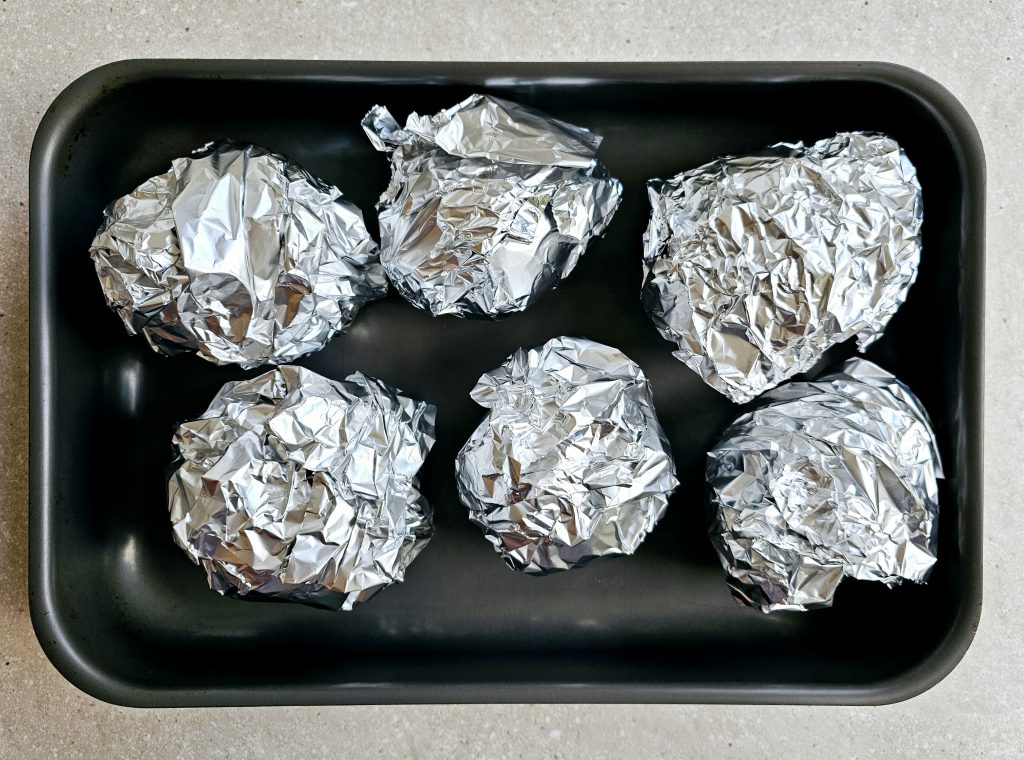
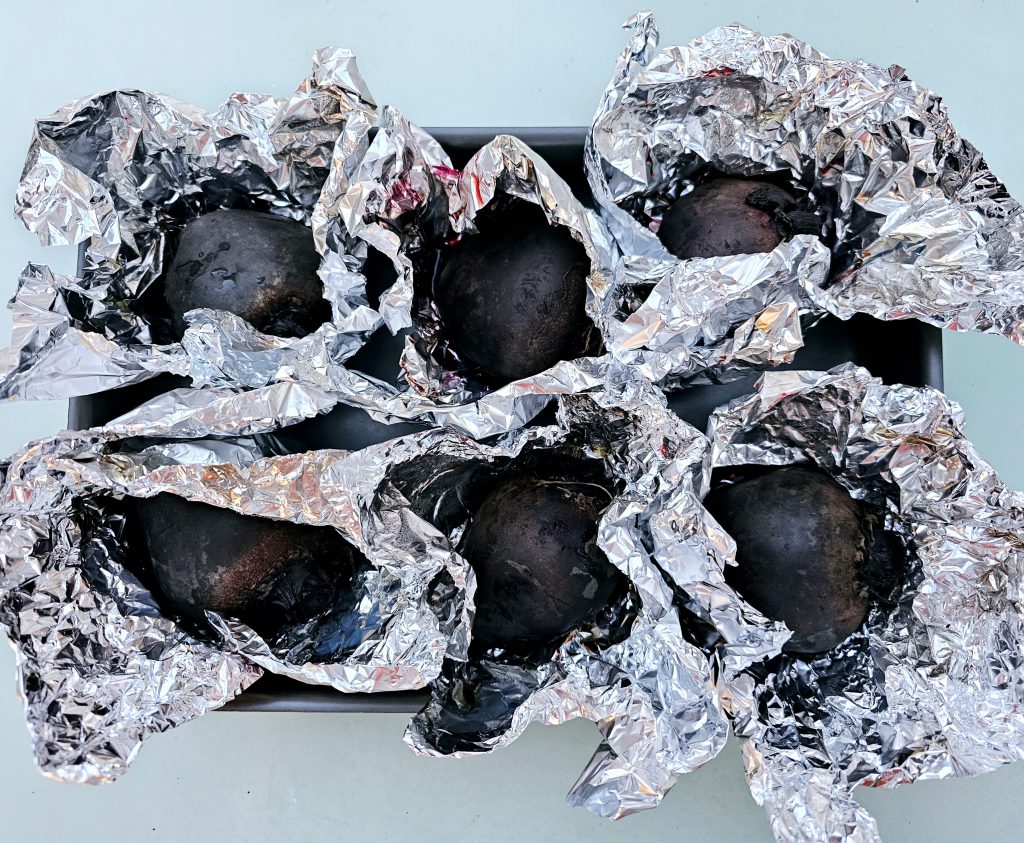
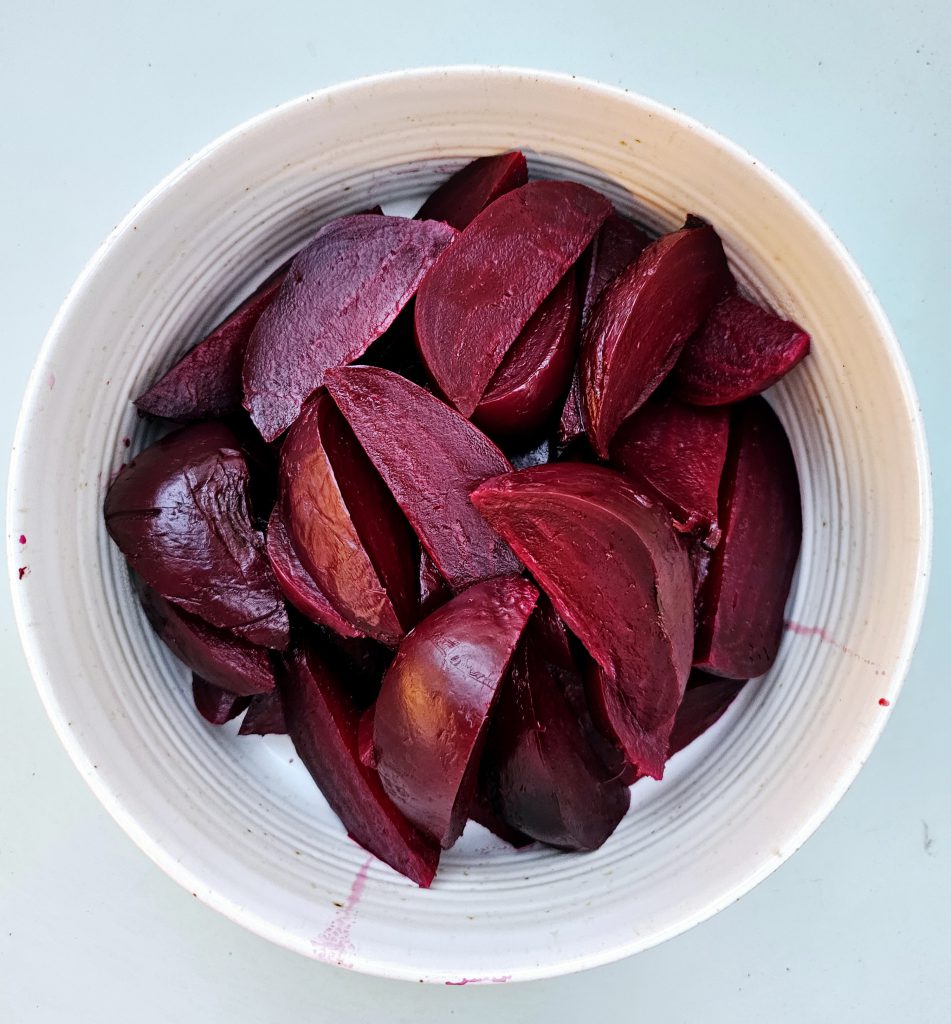
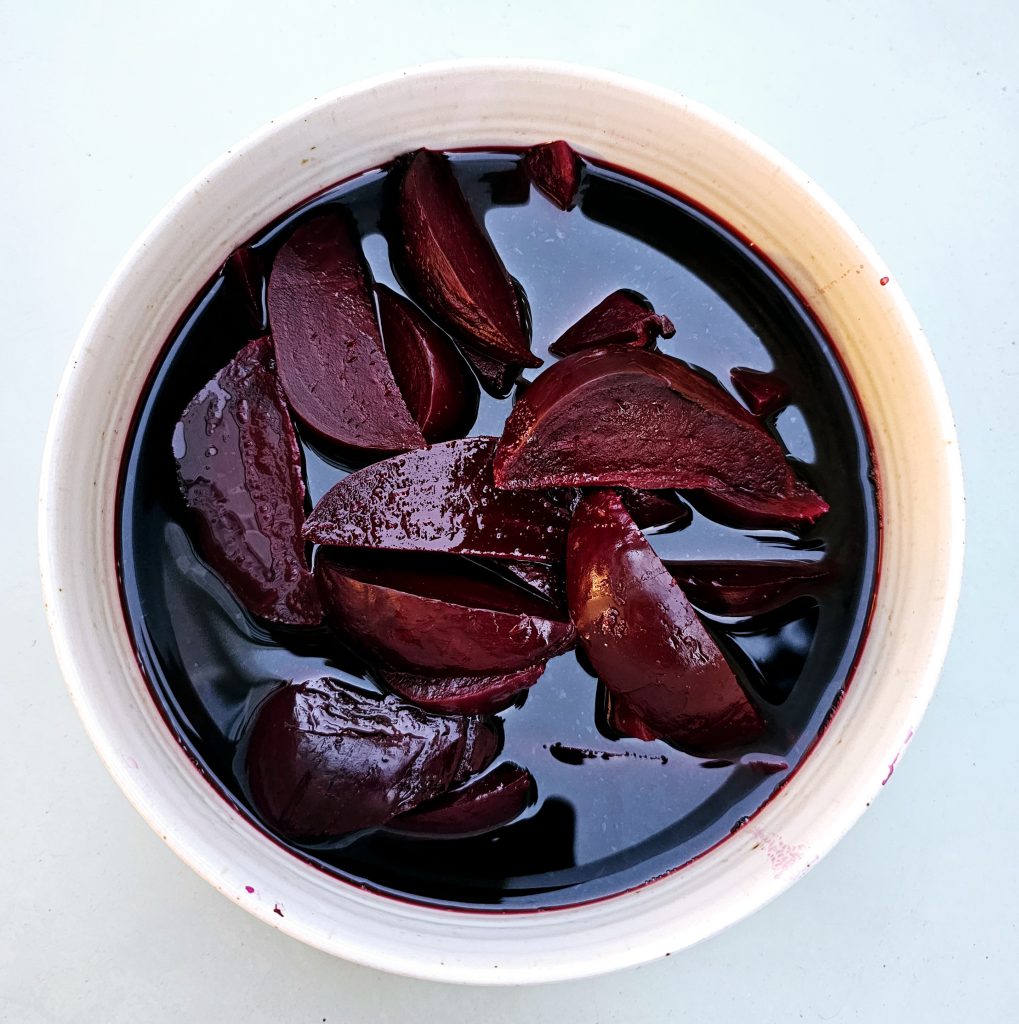
DAY 2
In the morning, preheat the oven to 70°C/ 55°C fan. Line 1-2 baking trays with baking paper.
Using a pair of tongs, remove the beetroot from the juice and place evenly on the baking tray. Reserve the juice for later.
Dry the beetroot in the oven for around 6 – 7 hours. This was my second attempt and I felt a bit more confident. Both timings seemed OK but I would not stray outside these limits.
The beetroot can be used immediately or kept for later.
Just before serving, place the beetroot into a pot with the reserved juice and pomegranate molasses. (For one portion, use six wedges of beetroot, 80 g reserved juice and 2 teaspoons pomegranate molasses).
Bring everything to a boil to reduce the juice a little. Remove the pot from the heat.
To serve, arrange the beet and juice in the middle of a deep plate. Place a few pieces of the endive on one side, and a dollop of labneh on the other side. Drizzle over with the olive oil (1 – 2 teaspoons if making individual portions) and serve immediately.
Day 2: the beetroot before and after dehydrating in the oven for 6 hours

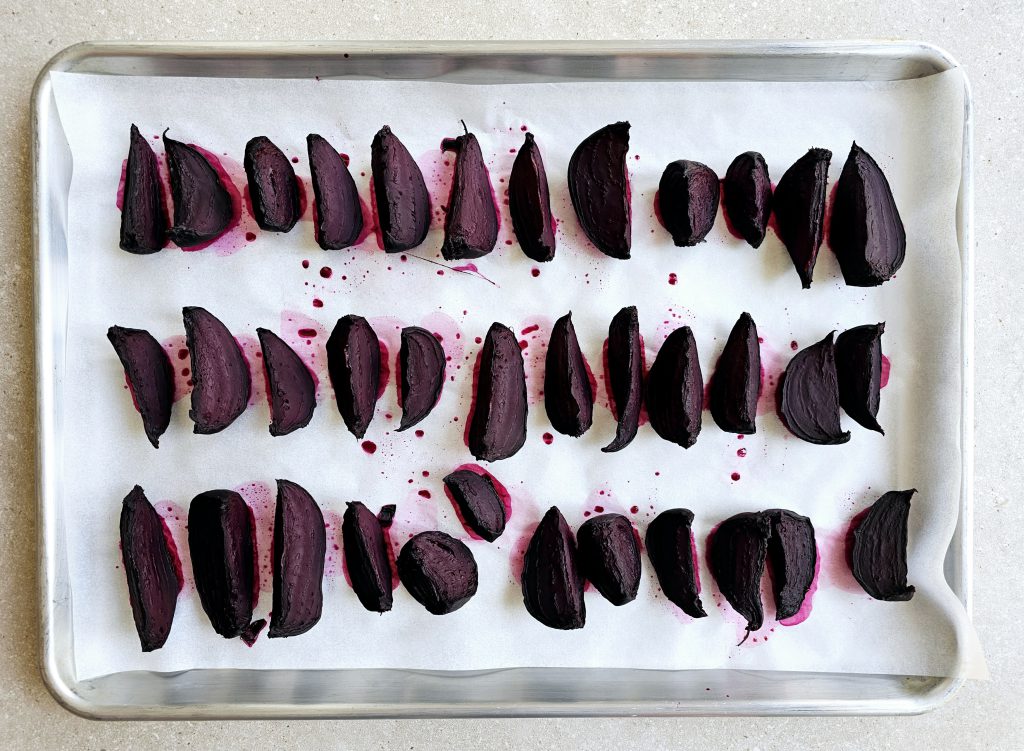

Plating up: my second attempt (top) and first attempt (bottom)
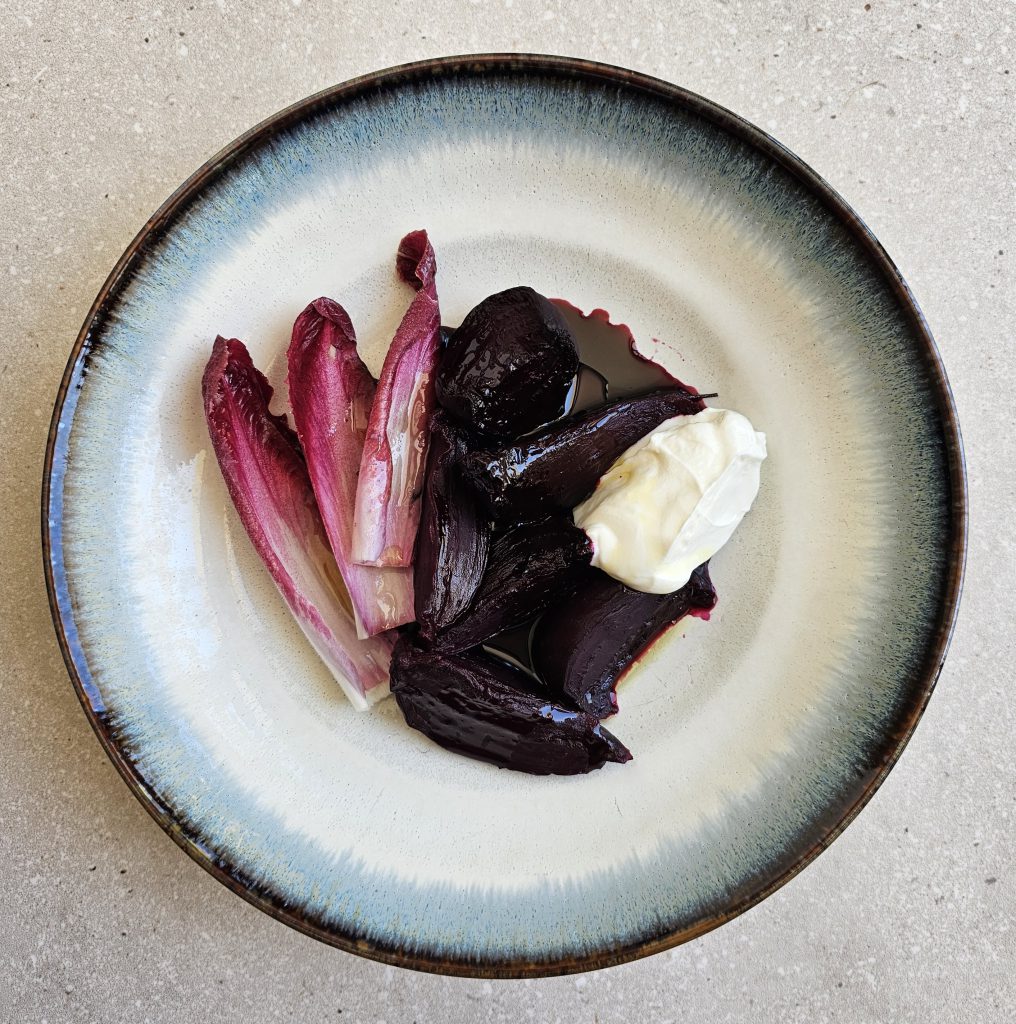
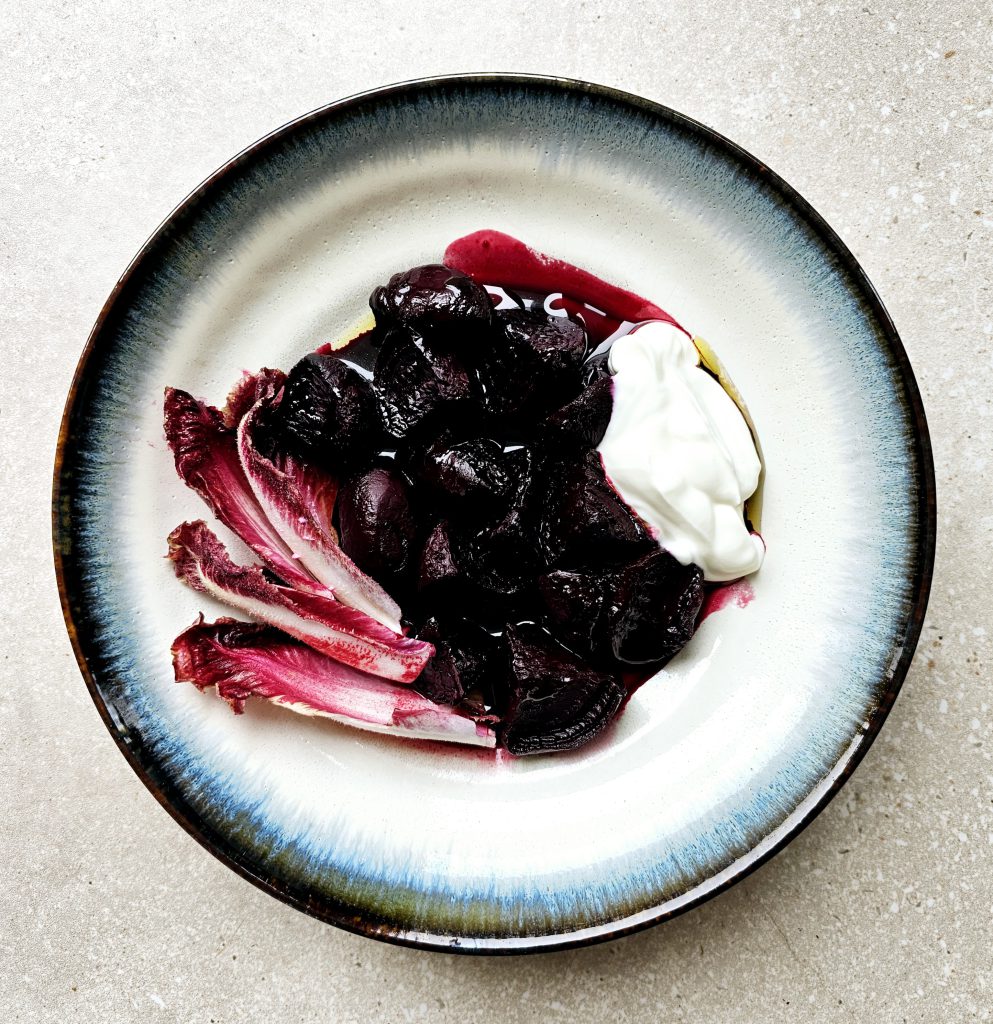
I was very glad that my only companion at the restaurant was Mr Gochugaru, who after 34 years of marriage knows that I am usually not one to lick the last drop off a plate. I know he is not like that either. However we found ourselves taking turns to scrape, with our spoons, what we could of the remaining juice. Happily I don’t have worry about this in my own kitchen. This afternoon, after trying out the second batch with Junior 3, I simply added more yogurt to the remaining juice and ate it like a sort of savoury yoghurt treat.

Date, Banana and Tahini Bundt

I have just finished watching the latest series of Masterchef UK and am in full admiration of the competitors and their ambition. Most would like to own and run at least one restaurant, and to achieve Michelin star status. Me? I am happy to get to the end of the day with something decent on the table.
This is why I love baking. It is so, so simple to bring together a few ingredient and have something to show for it an hour later. Recently I have been baking my cakes in Bundt pans and re-working a few older recipes. I am trying out spelt flour in my cake baking for a change, instead of using regular wheat flour. In line with the doctor’s advice, I have also reduced the sugar by 20%.
Today’s cake includes dates, banana and tahini. The original recipe (made in a square tin) is here, which has notes on which type of tahini to use. Make sure you stick a long metal spoon into the tahini before first using, to scrape up the solid paste which has settled at the bottom of the jar. Stir this solid paste into the more liquid paste on top.
For today’s cake I used a Lebanese tahini

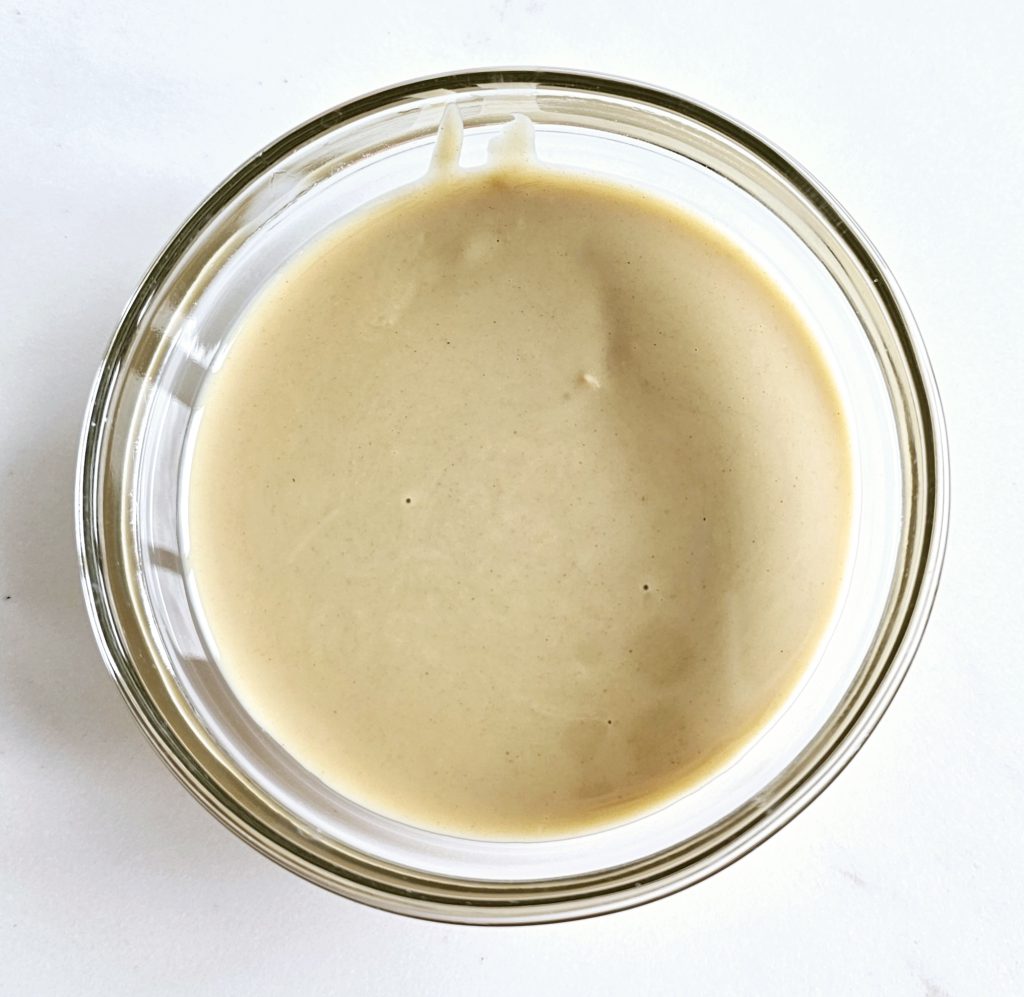
Simple but naturally sweet additions of crushed bananas and chopped dates lessen the need for too much sugar in the cake
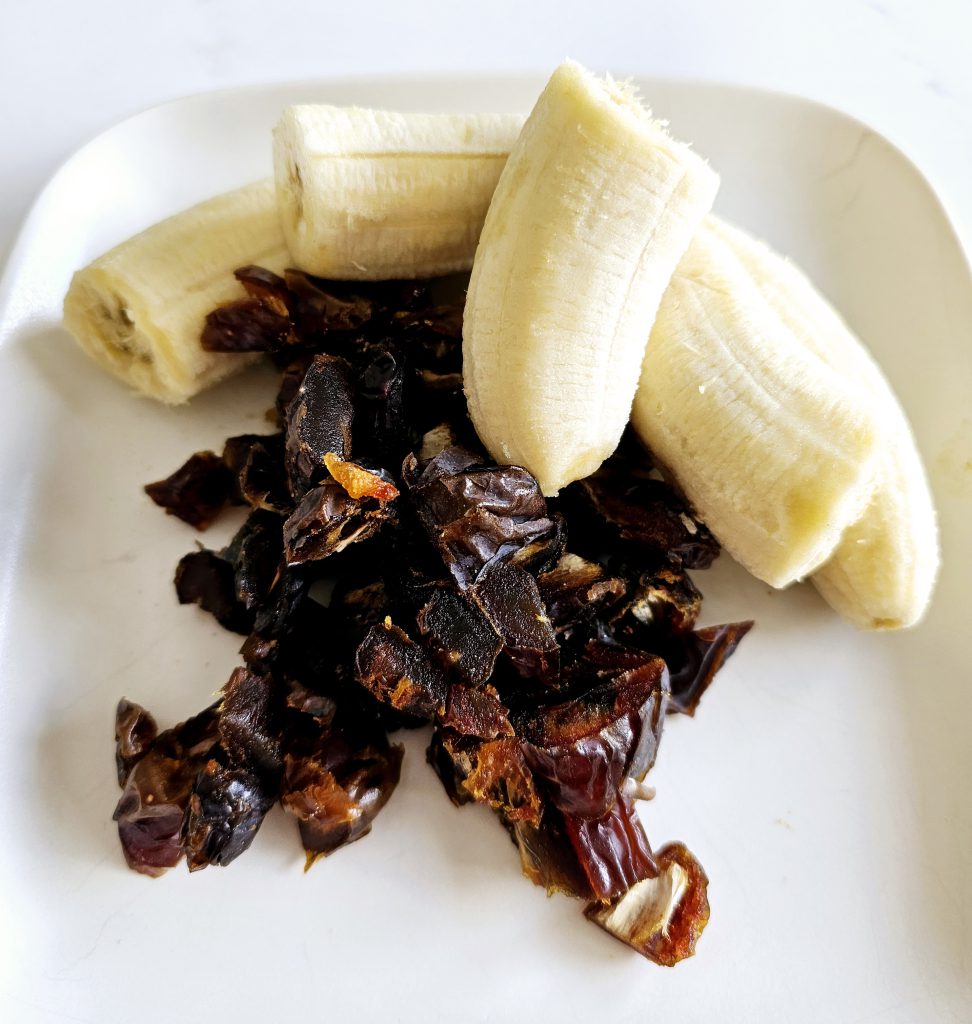
I used a 6 Cup Anniversary Bundt Pan and prepared it with butter, sesame seeds and flour, to prevent the cake from sticking
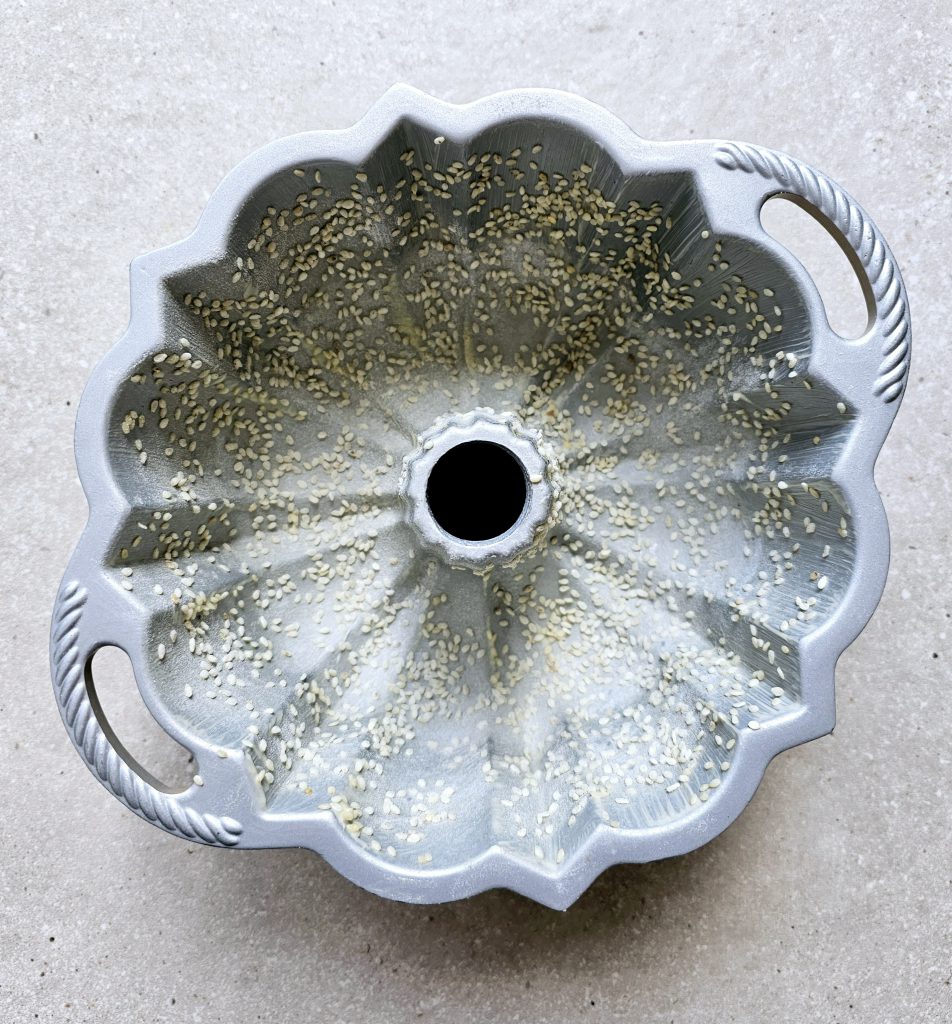
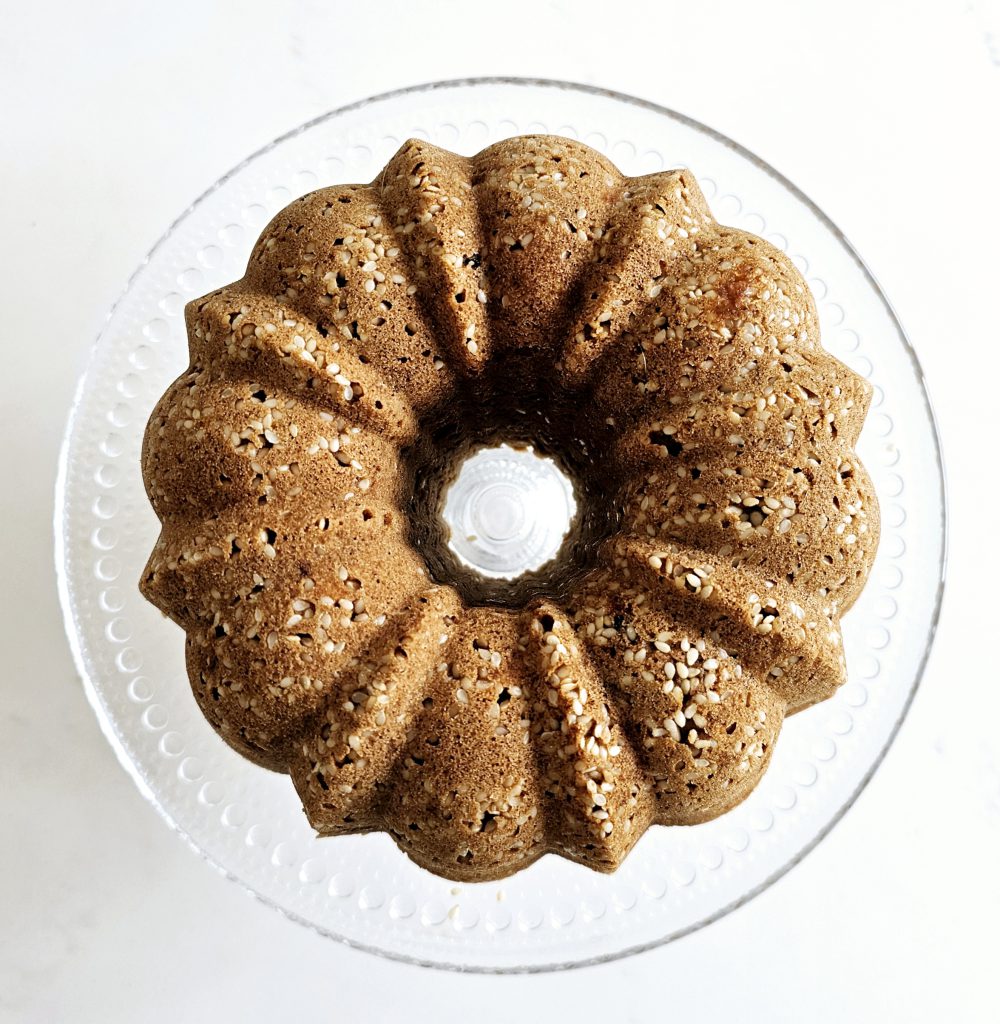
For the Cake:
2 large eggs
80 g light or dark brown soft sugar
100 g sunflower oil
175 g wholegrain or white spelt flour (I used a 125 g wholegrain/ 50 g white mixture)
1½ teaspoons baking powder
¼ teaspoon bicarbonate of soda
Pinch of salt
150 g pitted Medjool dates, cut into small pieces
200 g ripe bananas, broken into pieces and lightly crushed
50 g tahini (preferably Middle Eastern tahini)
1 teaspoon vanilla extract
10 g each softened butter and plain flour to line the Bundt pan
2 – 3 teaspoons untoasted white sesame seeds
You will need a 6 Cup Anniversary Bundt Pan. The cake can also be made in a 2 pound / 900 g loaf tin or a 20 x 20 cm square tin.
How to Make:
Preheat the oven to 170°C/ 150°C fan.
Brush the softened butter evenly over the entire inside of the pan, taking care to fill every corner. Sprinkle over the sesame seeds, which will stick to the butter.
Sift over the flour, moving the pan around to coat evenly. Remove the excess flour by turning the pan upside down and giving it a tap (do this over a sink). Set the pan aside.
Sift the flours, baking powder, bicarbonate of soda and salt together into a large bowl. Set aside.
In a large mixing bowl, whisk together the eggs and sugar until thick and creamy. Whisk in the oil slowly.
Add the flour mixture and, using a silicon spatula, gently fold into the whisked egg mixture.
Add in the dates, banana, tahini and vanilla extract. Gently fold everything together until well mixed.
Spoon the mixture into the prepared pan.
Level the surface and tap the pan on a folded dishcloth to settle any bubbles.
Bake in the oven for 50 minutes or until the cake bounces back when touched. A metal skewer inserted in the centre should come out clean.
Leave the cake to cool slightly in the tin before turning out onto a wire cooling rack to cool completely.
The cake will slice into eight thin and eight thicker pieces – perfect for a sharing with friends, and perfect for picnics.

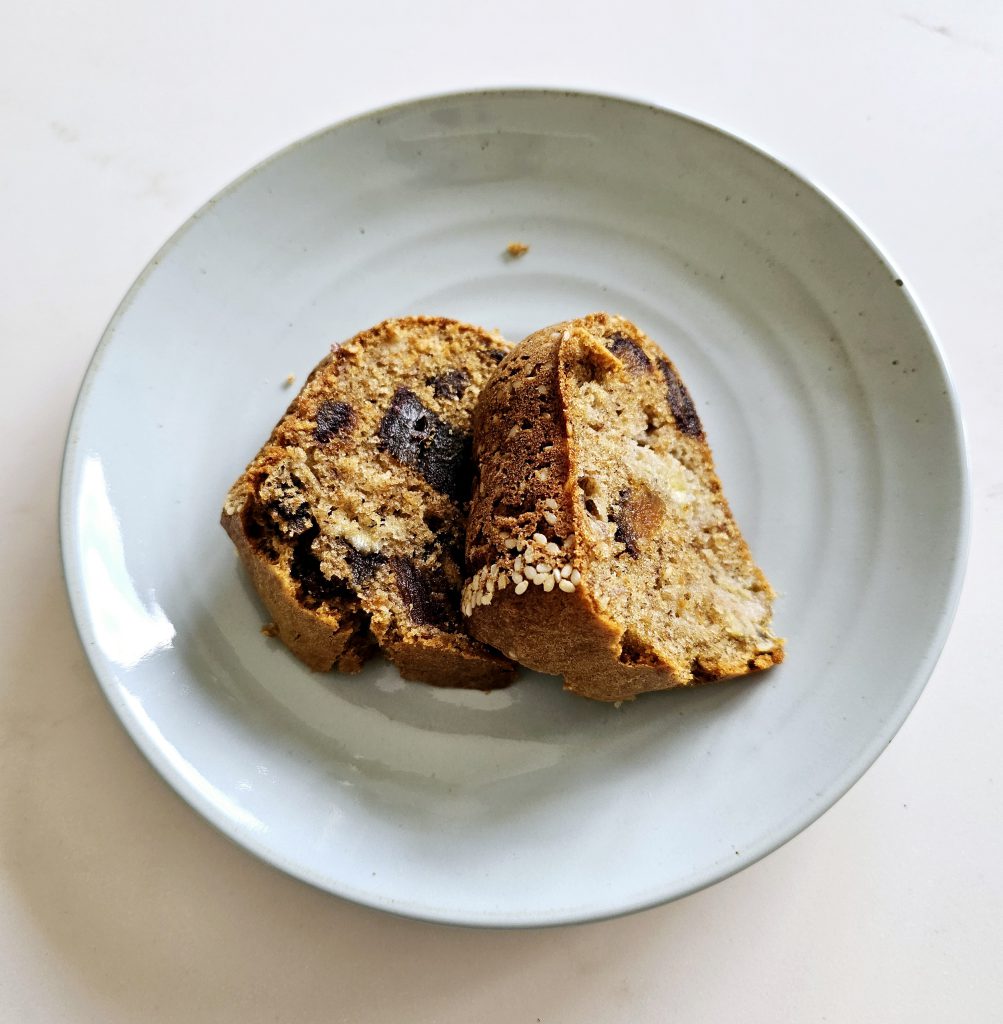
Millers of spelt flour in the UK: Doves Farm and Shipton Mill. I use their flours regularly and highly recommend them.
Date, Carrot and Coconut Bundt
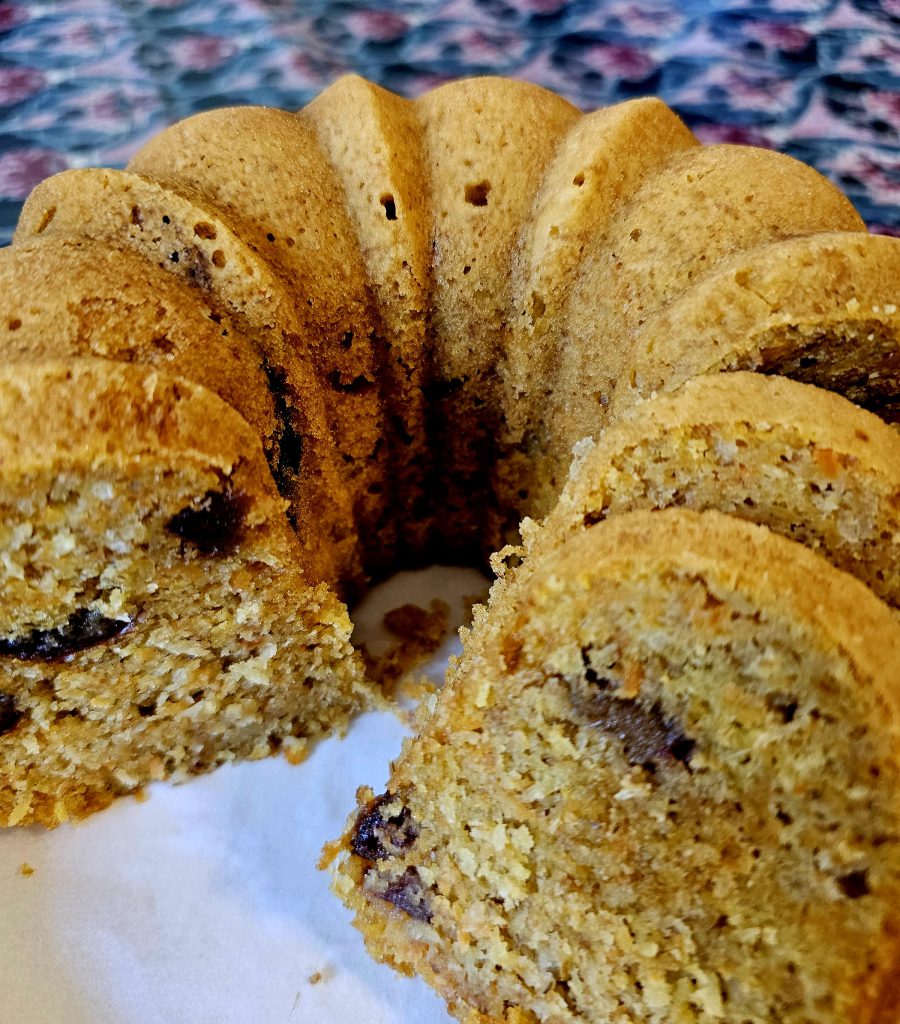
To be honest I am not sure how to photograph another Bundt, as all cakes made in the same Bundt pan will end up looking like each other. I was about to skip this post but then I brought this cake to a church meeting where it was very well received: one person asked for the recipe and another asked for a cake baking lesson. So I decided to include it here. There is only the one photo as I left the cake for the host and her family to finish later.
This cake is very fast to make, and the most important thing to stress is that you should weigh out and prepare all the ingredients before starting. I used a 6 Cup Anniversary Bundt Pan but the cake can also be made in a 2 pound / 900 g loaf tin, which was how I made it originally at the start of the pandemic. I have lowered the sugar and raised the fibre content in this update. The carrots were grated in my Thermomix Cutter.
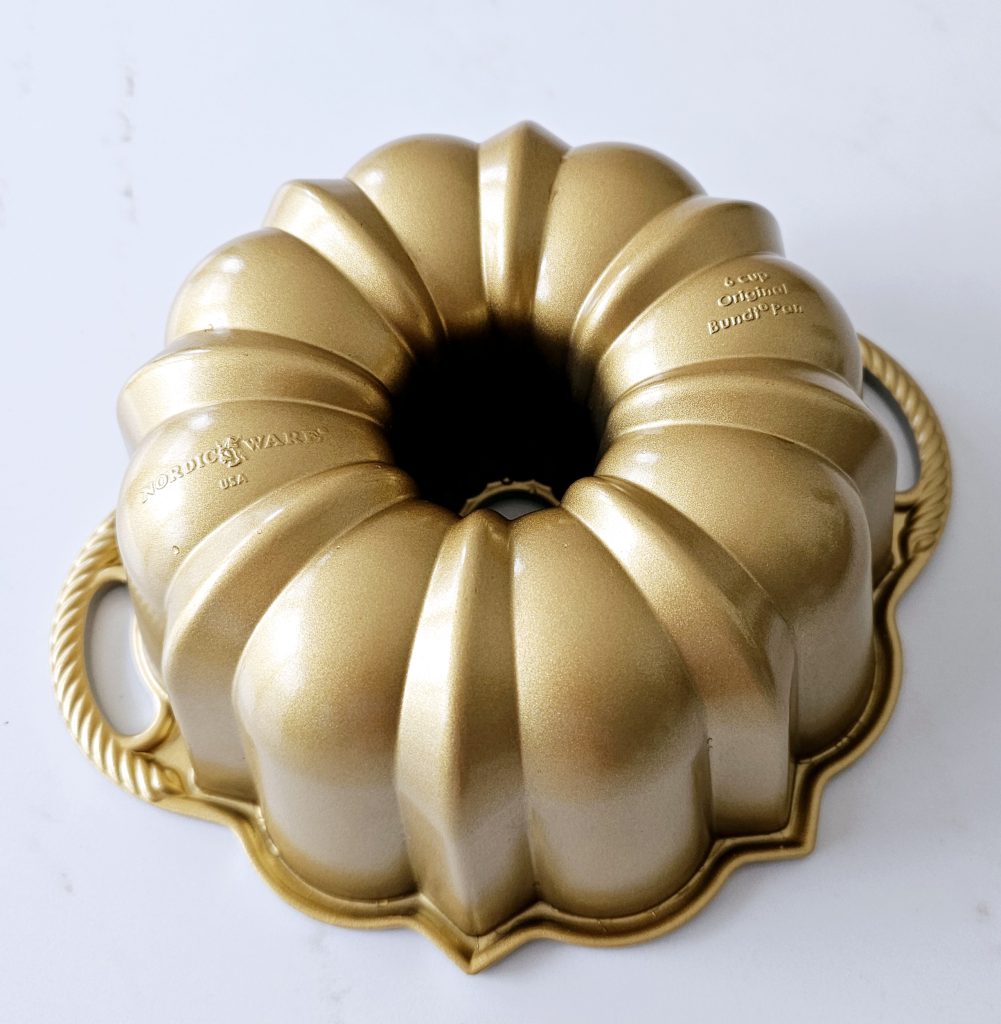
For the Cake:
3 large eggs
125 g golden caster sugar or light brown soft sugar
115 g sunflower oil
100 g spelt or wholemeal flour
50 g plain white flour
1½ teaspoons baking powder
Pinch of fine sea salt
100 g Medjool dates, cut into small pieces
50 g desiccated coconut
265 g carrots, finely grated
grated zest of one orange (optional)
10 g each softened butter and plain flour to line the Bundt pan
How to Make:
Preheat the oven to 170°C/ 150°C fan.
Brush the softened butter evenly over the entire inside of the pan, taking care to fill every corner. Sift over the flour, moving the pan around to coat evenly. Remove the excess flour by turning the pan upside down and giving it a tap (do this over a sink).
Sift the flours, baking powder and salt together into a large bowl. Set aside.
In a large mixing bowl, whisk together the eggs and sugar until thick and creamy. Whisk in the oil slowly.
Add the flour mixture and, using a silicon spatula, gently fold into the whisked egg mixture.
Add in the dates, coconut and carrots. Grate in the zest of an orange if using. Gently fold everything together until well mixed.
Spoon the mixture into the prepared pan.
Level the surface and tap the pan on a folded dishcloth to settle any bubbles.
Bake in the oven for 45 – 50 minutes or until the cake bounces back when touched. A metal skewer inserted in the centre should come out clean.
Leave the cake to cool slightly in the tin before turning out onto a wire cooling rack to cool completely.
The cake will slice into eight thin and eight thicker pieces – perfect for a sharing with friends, and perfect for picnics.
Carrot Cake Number Three
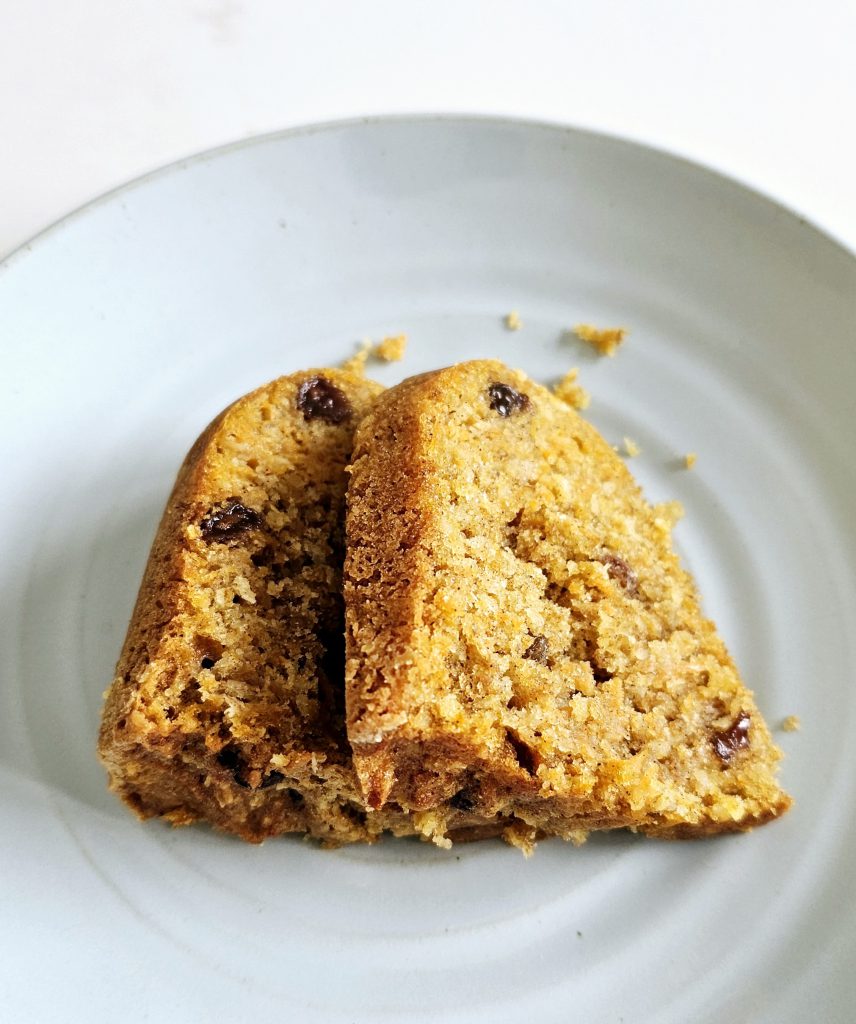
It has been an eventful weekend, and you can read about the coronation of King Charles III everywhere, and possibly forevermore. Our family has so enjoyed the extra day’s holiday, which we spent mostly doing more Spring cleaning.
Taking inspiration from Britain’s monarchy and its attempts to refresh its image, I have been refreshing my cake recipes by making them in Bundt pans. I used to write ‘bundt’ in previous posts but since reading that ‘Bundt’ is a trademarked word, I am using Bundt from now on.
I need to admit that I have quite a number of Bundt pans. The one I have been using a lot recently is the 6 Cup Anniversary Bundt Pan (gold edition). This is because its volume roughly equates to the volume of the 2 pound loaf tins I always baked cakes in. Like a loaf cake, the appeal of this Bundt pan is that its formed lines are a good guide for cutting even slices. At one stage when I was bulk baking for church and community events, I had six loaf tins. These Bundt pans are so crazy expensive here in the UK (but worth it) that I only have one of each type of pan. For now.
It is easy to slice from this cake following the lines of its shape…the dilemma is whether to eat a thin slice or a thicker slice
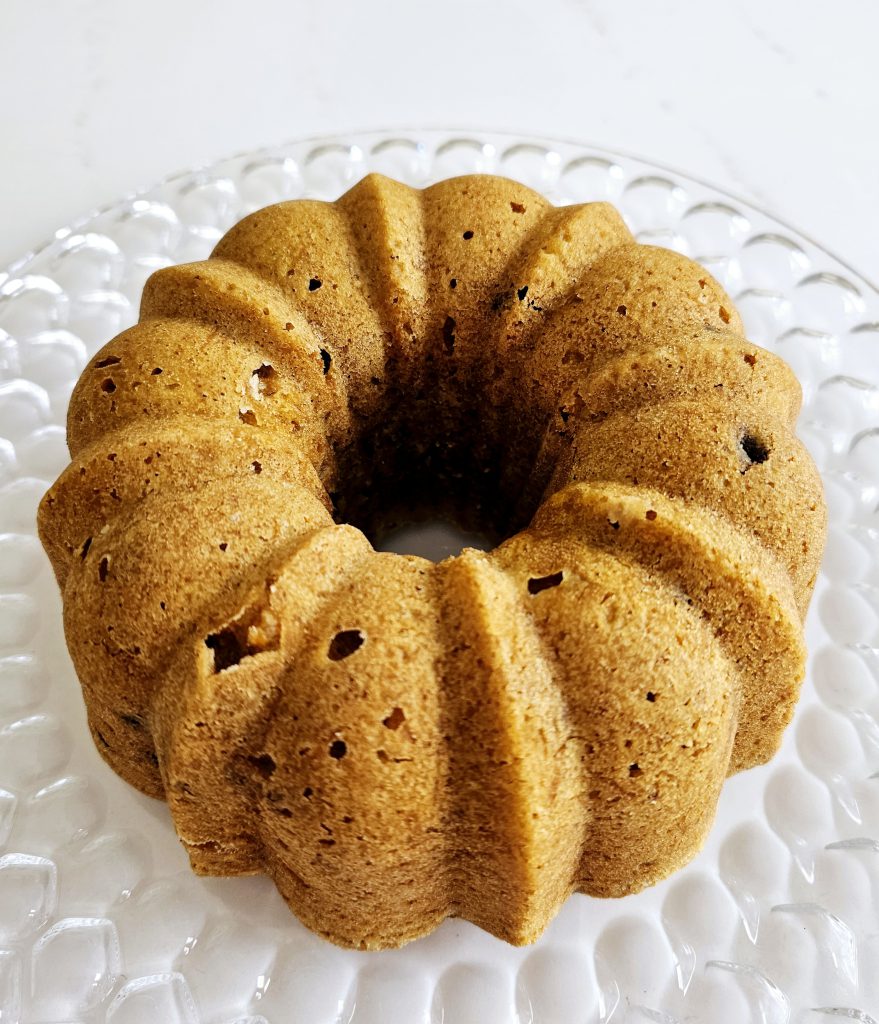
When reviewing the carrot cake recipe on which this Bundt is based, I realised that I don’t often keep wholemeal self-raising flour. Today I used a combination of spelt and plain white flours, with baking powder as the raising agent. I used sultanas instead of raisins, and one other thought I had was that the grated zest of an orange would be a nice addition to the batter.
Everything should be weighed and prepared beforehand. The carrots were grated in a few seconds using my Thermomix Cutter (grate fine). For fine grating, I have found that large carrots grate better than small carrots, which tend to come out more watery. You can of course grate the carrots by hand or in a food processor.
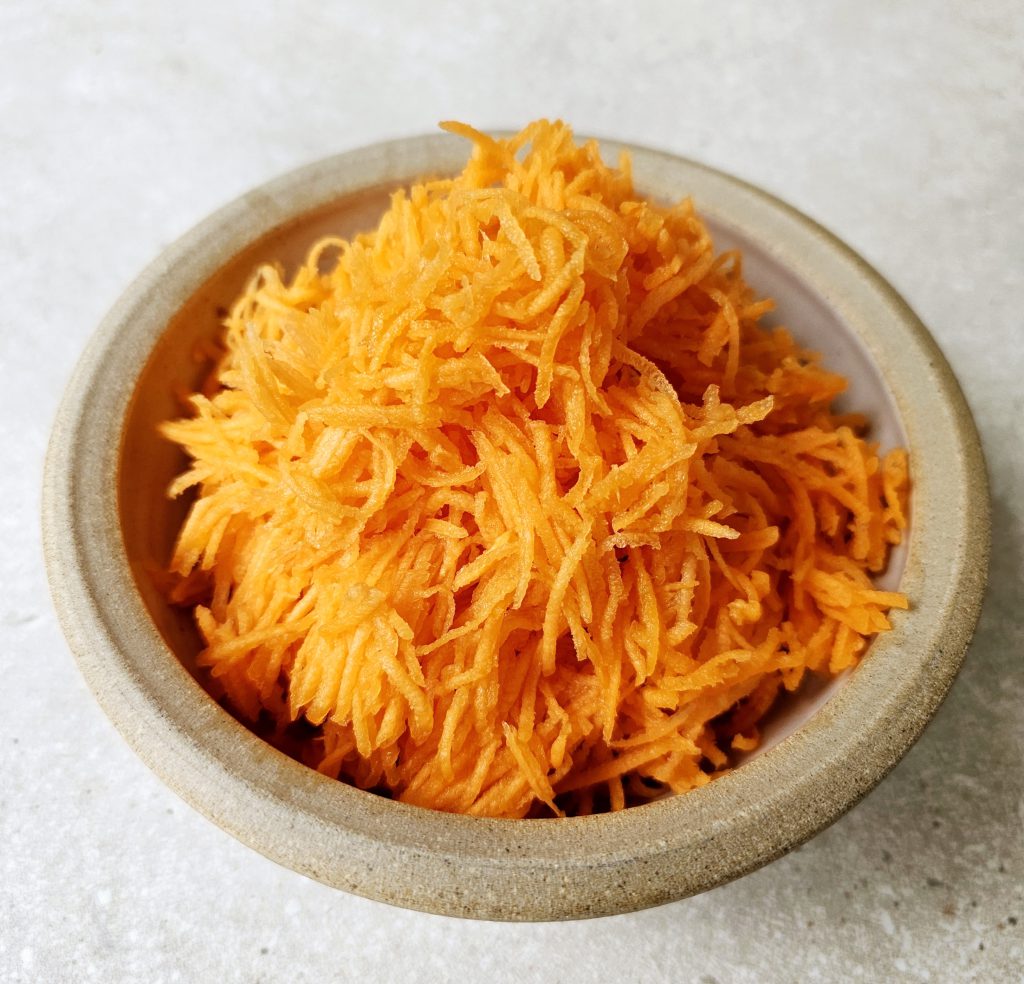
For the Cake:
3 large eggs
125 g golden caster sugar or light brown soft sugar
115 g sunflower oil
100 g spelt or wholemeal flour
50 g plain white flour
1½ teaspoons baking powder
1 teaspoon ground cinnamon
Pinch of fine sea salt
75 g sultanas
75 g desiccated coconut
265 g finely grated carrots
10 g each softened butter and plain flour to line the Bundt pan
How to Make:
Preheat the oven to 170°C/ 150°C fan.
Brush the softened butter evenly over the entire inside of the pan, taking care to fill every corner. Sift over the flour, moving the pan around to coat evenly. Remove the excess flour by turning the pan upside down and giving it a tap (do this over a sink).
Sift the flours, baking powder, cinnamon and salt together into a large bowl. Set aside.
In a large mixing bowl, whisk together the eggs and sugar until thick and creamy. Whisk in the oil slowly.
Add the flour mixture and, using a silicon spatula, gently fold into the whisked egg mixture.
Add in the raisins, coconut and carrots. Gently fold everything together until well mixed.
Spoon the mixture into the prepared pan.
Level the surface and tap the pan on a folded dishcloth to settle any bubbles. You can see in the photo above the little holes that form in the cake if you forget to do this.
Bake in the oven for 45 – 50 minutes or until the cake bounces back when touched. A metal skewer inserted in the centre should come out clean.
Leave the cake to cool slightly in the tin before turning out onto a wire cooling rack to cool completely.
The cake will slice into eight thin and eight thicker pieces – perfect for a sharing with friends, and perfect for picnics.
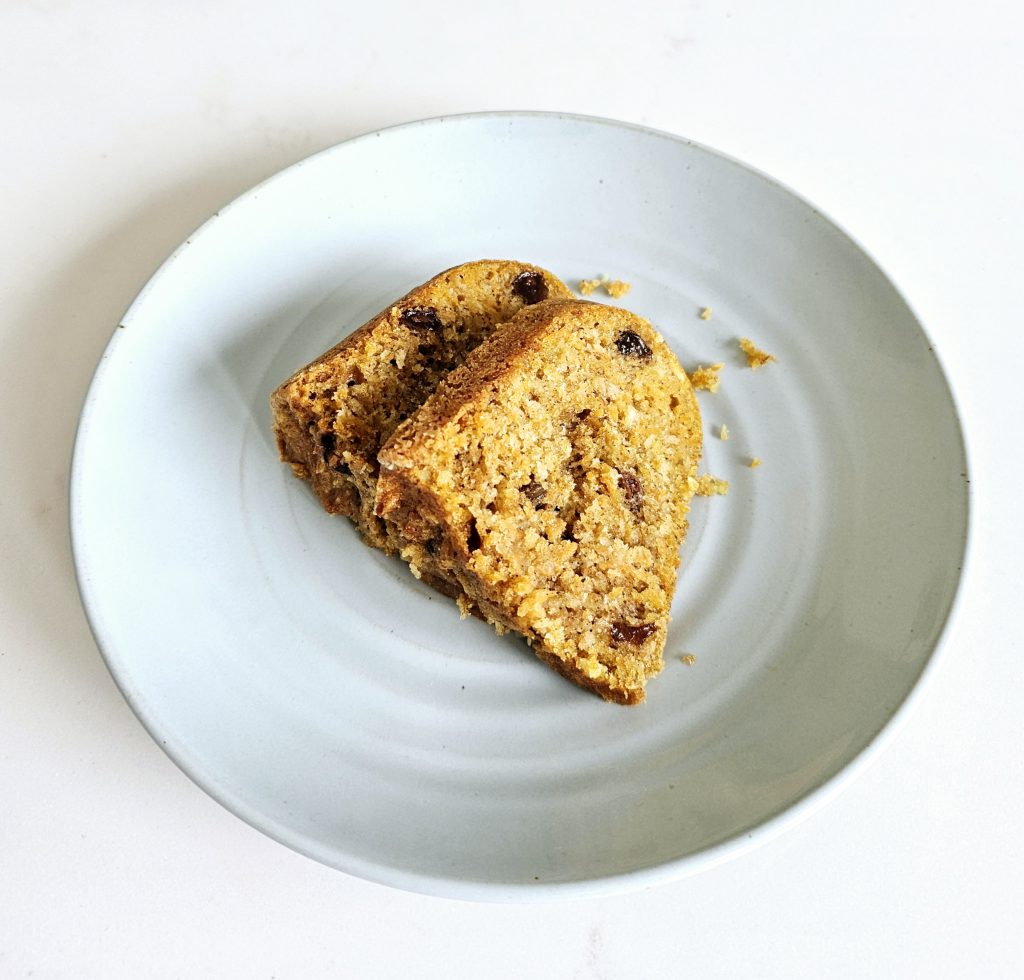
My next cake refresh would be the Date, Carrot and Coconut Cake, as I need to get through a box of Medjool dates. Originally planned for Sticky Toffee Pudding, a sharp warning from the doctor to reduce my sugar intake has resulted in the said dates (and sad dates) being literally left on the shelf. However, I hope to make a gluten-free version of the STP when we visit my in-laws next weekend. They can enjoy it, and I will just have a spoonful after dinner.
Coronation Chicken Salad
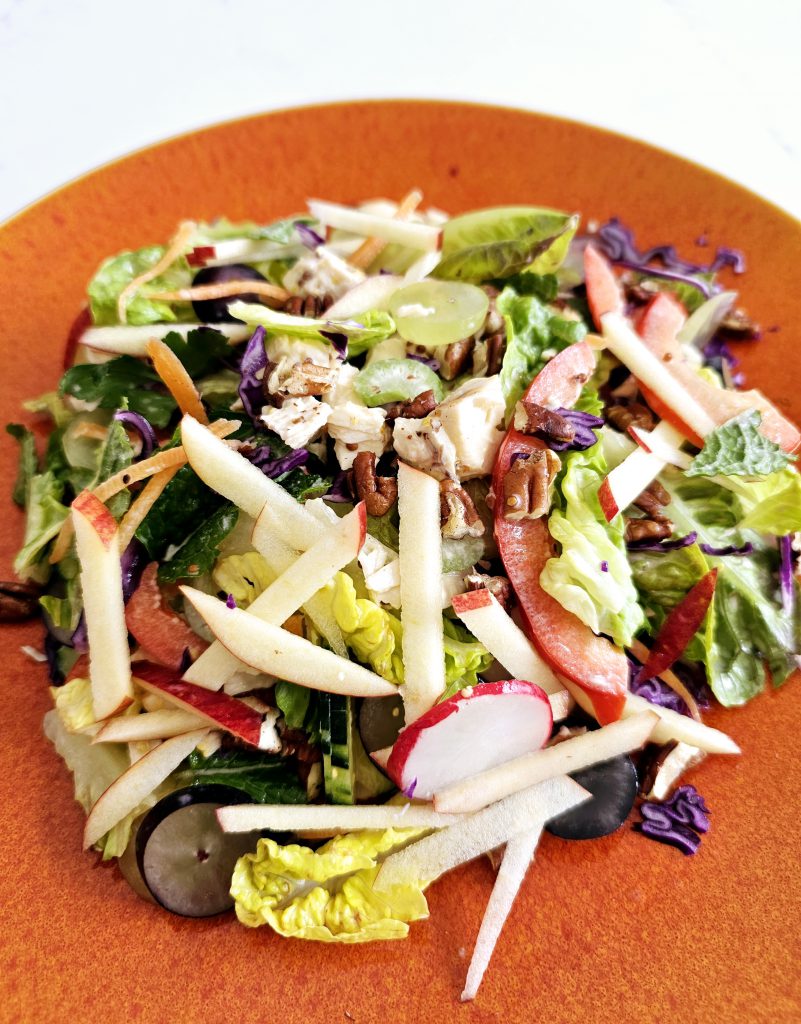
From the Old Testament of the Bible, in Judges chapter 21 verse 25:
In those days there was no king in Israel. Everyone did what was right in his own eyes.
Why do we have kings and queens? What purpose do they serve in a modern world? When we read accounts of royalty in history, we understand that one of the king’s role was to protect his kingdom where there were no geographically defined borders. This was mainly done by raising and leading an army to defend land and people. Ultimately if need be, a king had to to sacrifice his life in order to save those who serve him.
That’s the kind of king I should like if I were to swear allegiance.
In the Bible, one of the functions of the king was to lead God’s people in God’s moral and spiritual ways. There were good kings and there were bad kings. Sometimes things went well and sometimes things did not go so well. Then there was a period when there was no king, and without a leader directing the people as to God’s way, everyone was a law unto himself.
It is not difficult to imagine what life was like at this time. All we need to do is to read the daily news to see God’s original commandments still being broken: murder, adultery, theft, false witness, envy. The Bible makes it clear that all this stems from putting ourselves first instead of seeking God’s will and direction.
This is not a political essay, and my background is in Law and not in Theology. But I often think about how difficult it is to be a leader when you do not have any moral compass or grounding. So my prayer every morning is that God helps me make good and wise decisions when I am faced with a dilemma or predicament.
In my world, baking cakes or cooking do not often cause dilemmas or predicaments. However, I could not make progress on what to cook this Coronation Weekend. No one in the family wanted to eat Coronation Chicken. None of us were born when the late Queen Elizabeth had her coronation. In my recollection, this is a salad made up of cooked chicken, raisins, curried mayonnaise and topped with toasted flaked almonds. I think we ate it at our own wedding (and I think my dad enjoyed it very much).
I like all things chicken so decided to make my own version of Coronation Chicken. This is a large raw salad topped with a small amount of chicken bound in a light dressing and chopped toasted nuts. It does not resemble the original, but then King Charles does not resemble his beloved mother in many ways. I hope his reign will be memorable, as much as I hope my chicken salad will be too.
Some of the salad and dressing ingredients
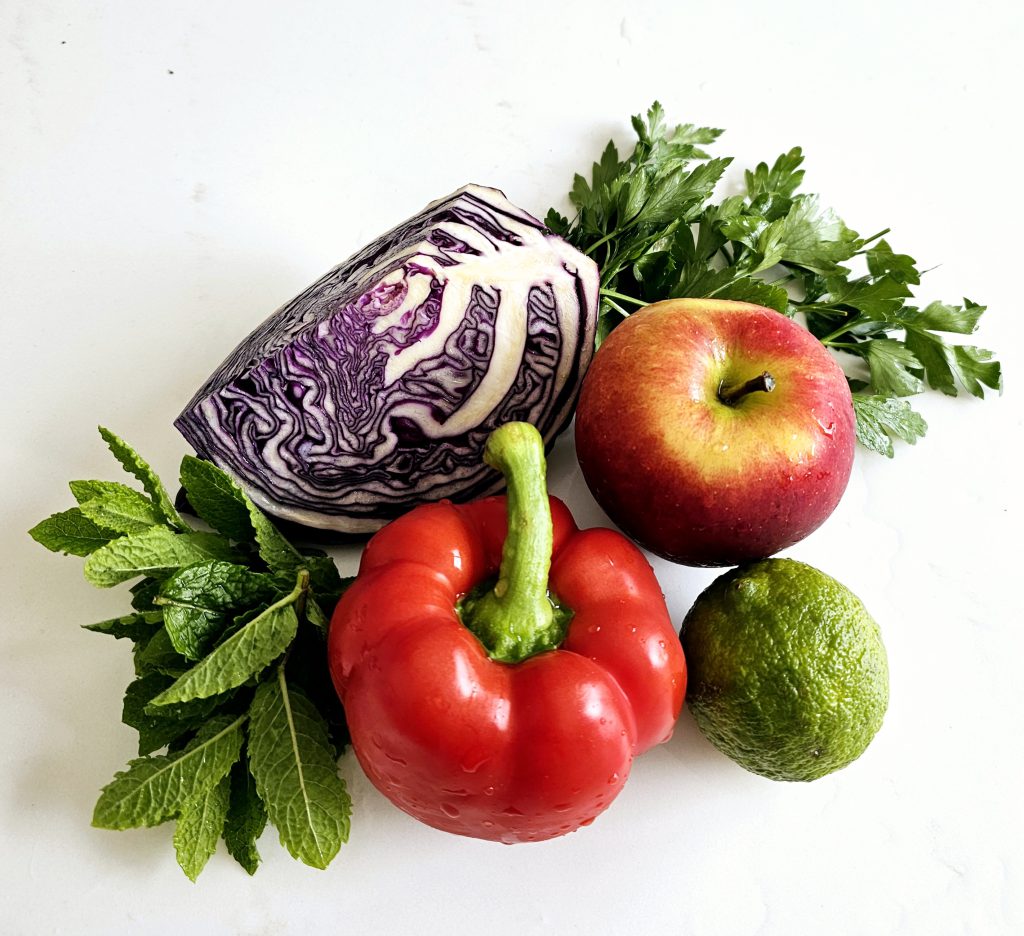
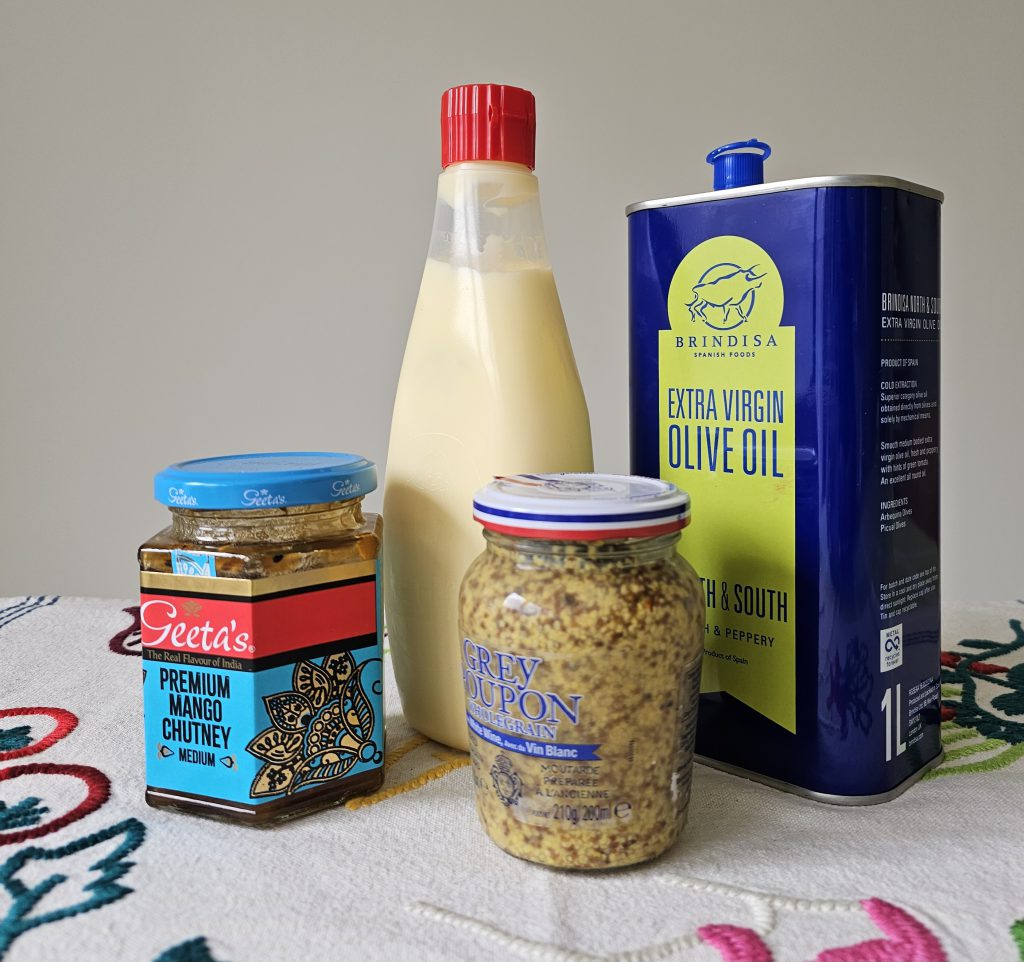
For the Salad:
Use any amount of torn salad leaves, shredded or sliced crunchy vegetables, apple, grapes and fresh herbs. Below are suggestions. Wash and dry the vegetables and fruits and make a salad as you normally do.
Salad leaves could be little gem, rocket, iceberg lettuce, butter lettuce.
Crunchy vegetables could be small radishes, celery, sweet peppers, cucumber, red cabbage, green cabbage, carrots.
Fruits could be apples and grapes. Nothing sour (see note at the end of the post). Maybe some pear but only if it is crunchy, like Nashi pear.
Herbs could be rocket, flat-leaf parley, mint.
Nuts could be pecans, cashews, walnuts. For something extra I would use smoked and salted almonds.
For the Chicken:
This is the important part that brings the dish together and gives it the Coronation element. I used 120 g of cooked and cubed chicken breast for two people, but please use more if you need to provide a more substantial salad.
For 120 g of cooked and cubed chicken breast, the dressing is 1 tablespoon mayonnaise, 1 tablespoon mango chutney, 1 teaspoon olive oil, 1 teaspoon lime juice, 1 teaspoon wholegrain or Dijon mustard, few turns of freshly ground pepper and grated zest of 1 lime.
Assembling the Salad: start with the salad leaves, add the shredded crunchy vegetables, top with the dressed chicken and chopped nuts
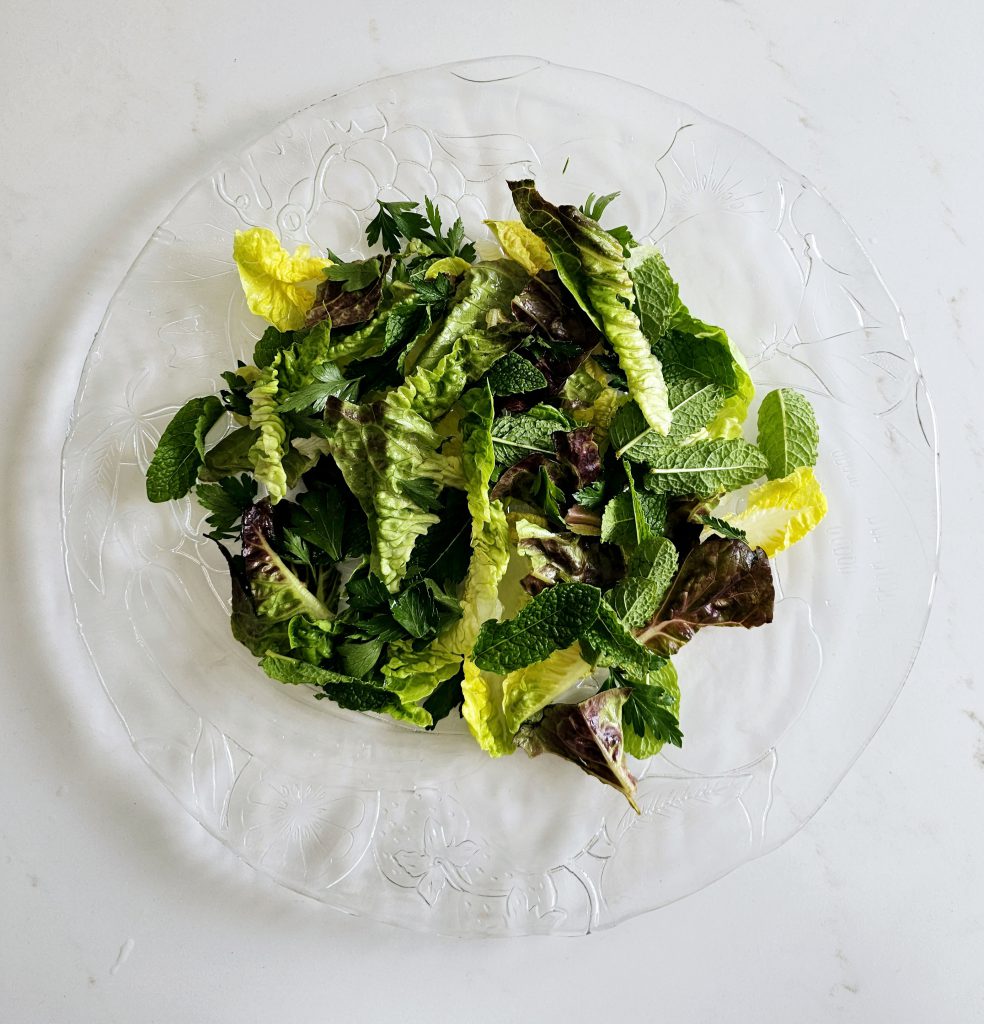

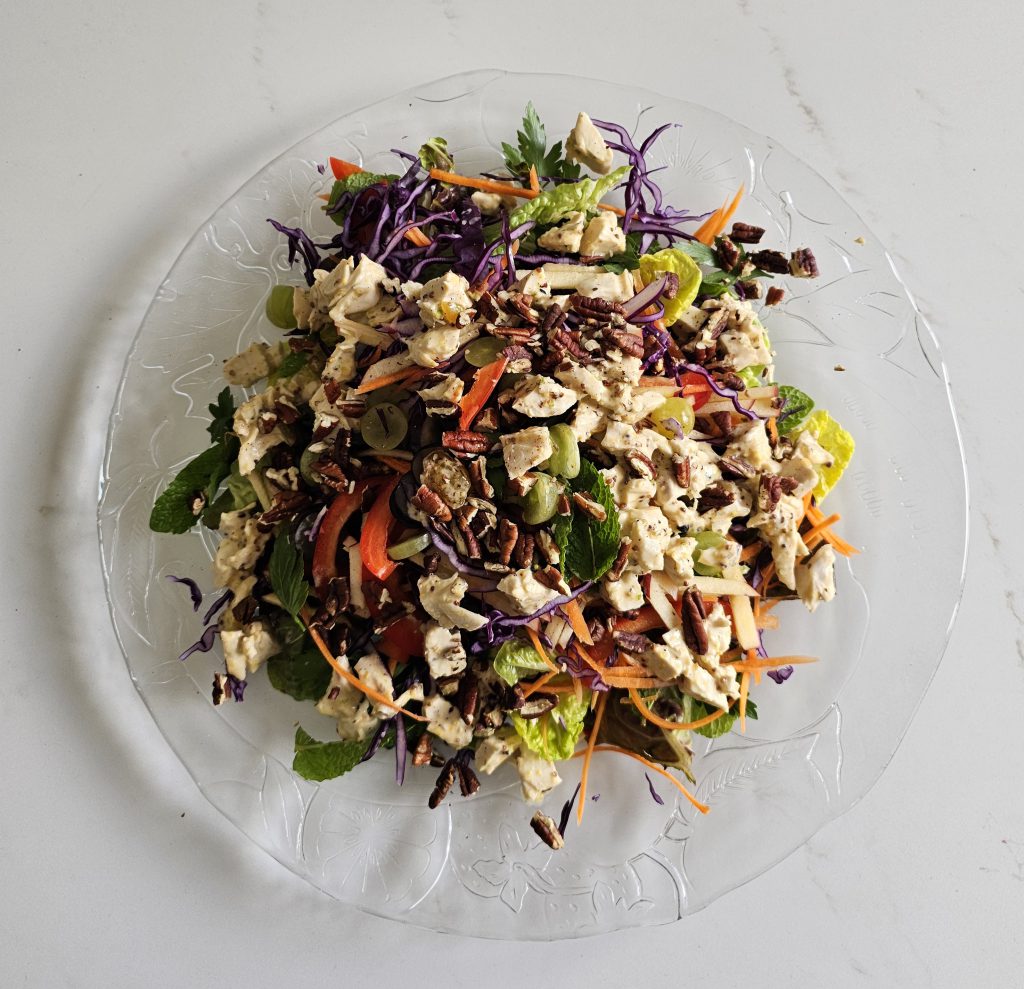
I had a little chuckle to myself when thinking up this recipe. I thought that I should like this salad to be like the ideal monarch. That is to say, not bitter (this is why I avoided chicory, radicchio) and not sour (hence only a little lime juice and no sour fruits). A little feistiness (rocket, radish), mainly home-grown (our local carrots, red or green cabbage, apple, celery, mint, parsley), with some global influences (grapes from South Africa, French mustard, Spanish olive oil, Japanese mayonnaise). A little nuttiness is totally ok. Overall I wanted something fresh and easy going, not heavy or overbearing.
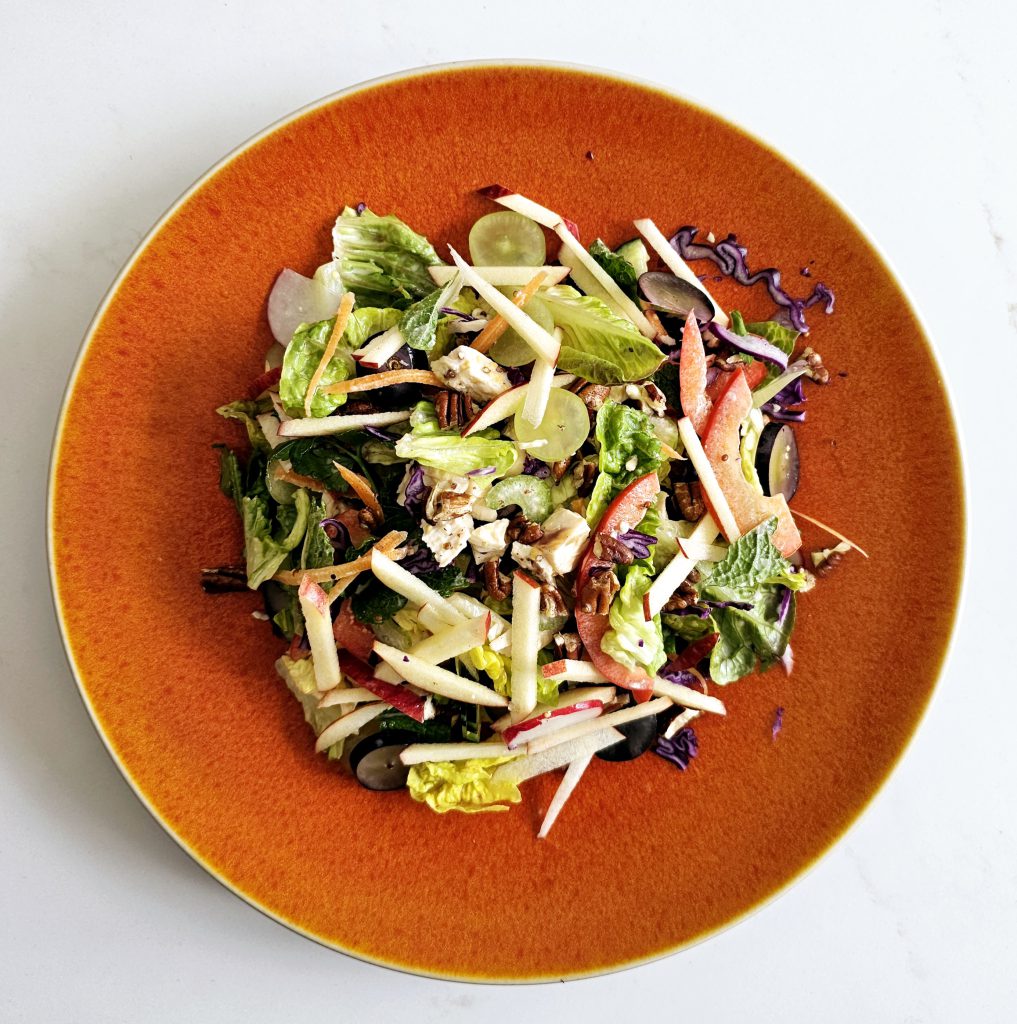
Three Salads and a Rice
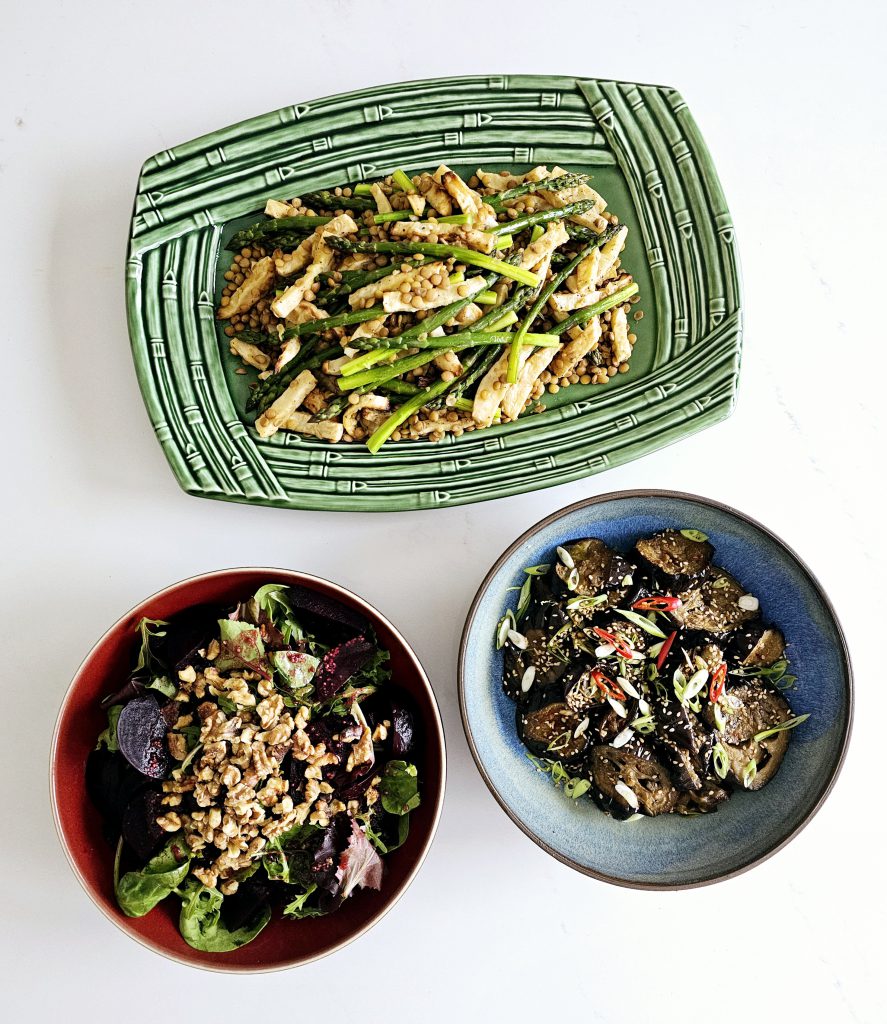
Any night is a good night to see the children for dinner. I am happy to spend time in my kitchen whether it is the weekend or the beginning of the working week. Tonight I made three salads, a beef curry, some rice and a pistachio bundt with fruits for dessert.
Need I say it? It is raining as I write. I know some men have Man Caves where they try to hide away from the world. But you can’t get away from the rain! After nearly 40 years of living in England, I have come to accept (but not entirely embrace) it.
The three salads are very simple to make, provided you use the oven to roast the main vegetables of aubergine, celeriac, beetroot. Recipes follow for each salad, with a photo at the beginning of the recipe.
Salad Number 1: Roasted Aubergine with a Soya and Maple Dressing
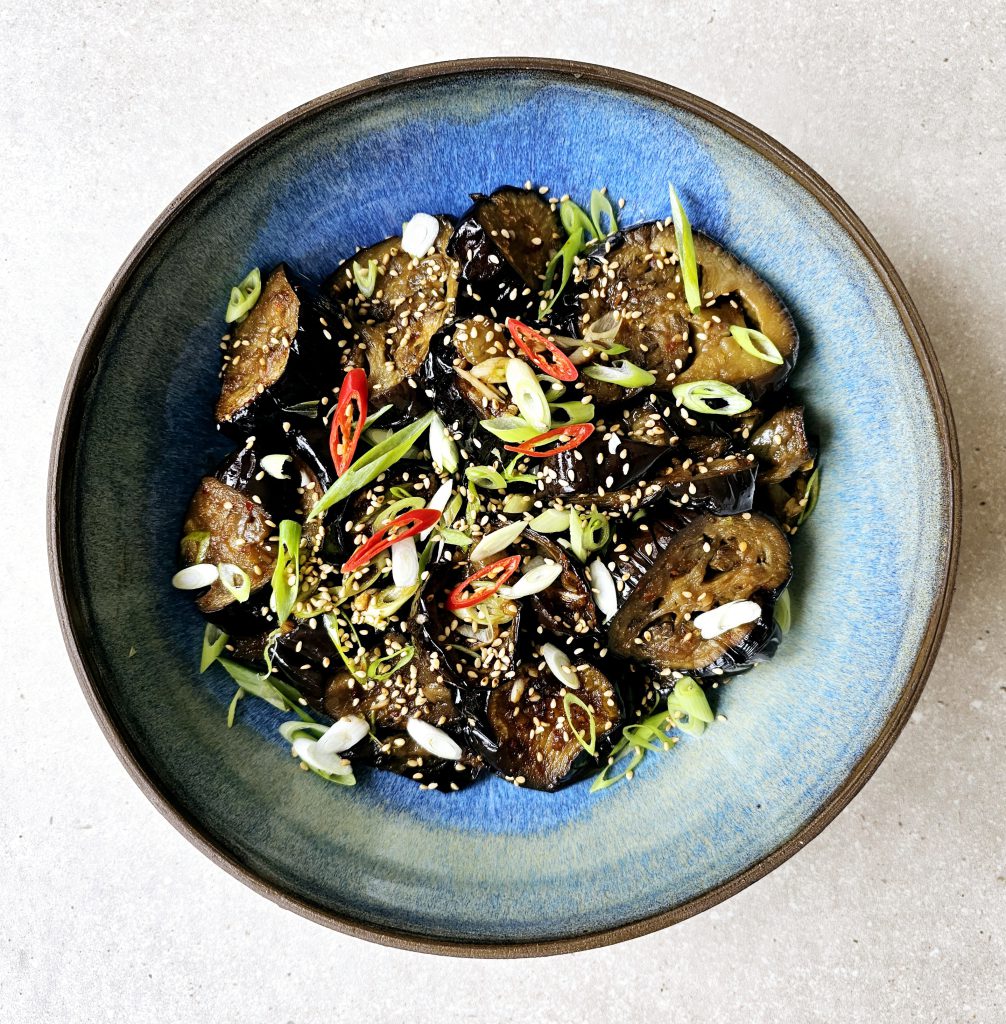
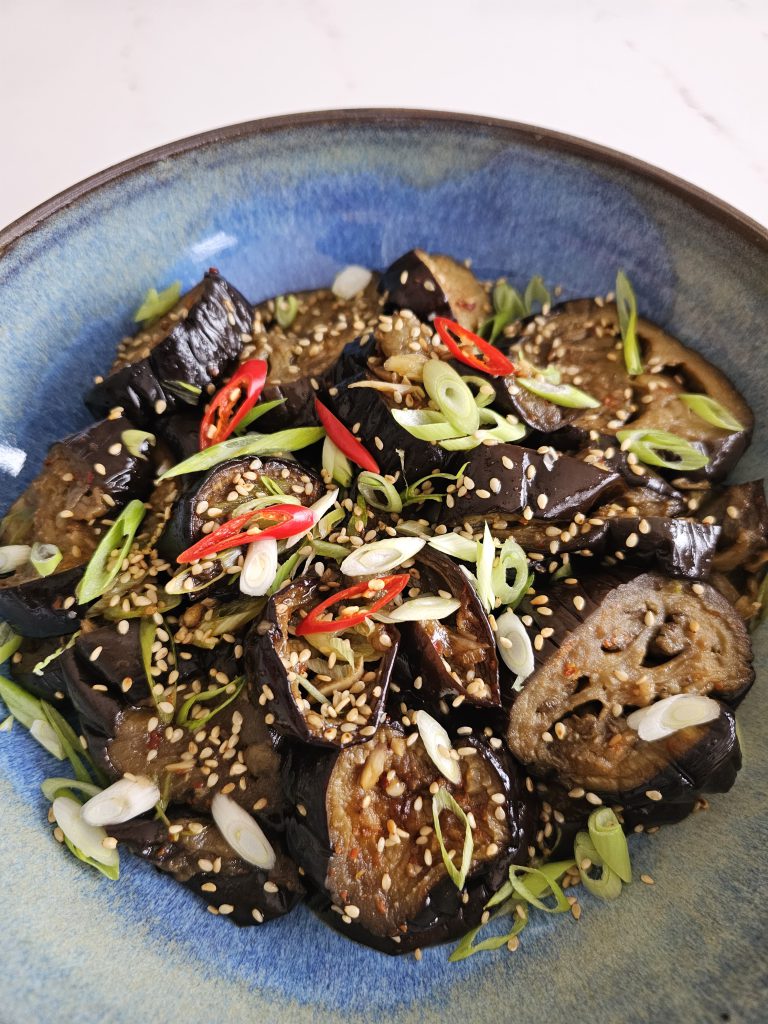
Vegetable: 3 large aubergines, olive oil
Dressing: 2 tablespoons soya sauce, 1 tablespoon sesame oil, 1 tablespoon maple syrup, 1 teaspoon gochugaru (Korean chilli powder)
Garnish: spring onions, sesame seeds, red chilli
How To:
Preheat the oven to 180C fan.
Cut the aubergines widthways into 2 cm slices.
Line a baking tray with greaseproof paper and drizzle on some olive oil.
Place the aubergine slices on the tray in one layer. Drizzle over more olive oil. Roast for 40 minutes, turning over once.
Whilst the aubergines are roasting, mix the dressing in a large mixing bowl.
When the aubergines are ready, tip them into the bowl and toss them gently in the dressing.
Place the aubergines on a serving plate and garnish with some sliced spring onions, sesame seeds and sliced chillies.
Salad Number 2: Roasted Beetroot with Salad Leaves and a Sherry Vinegar Dressing
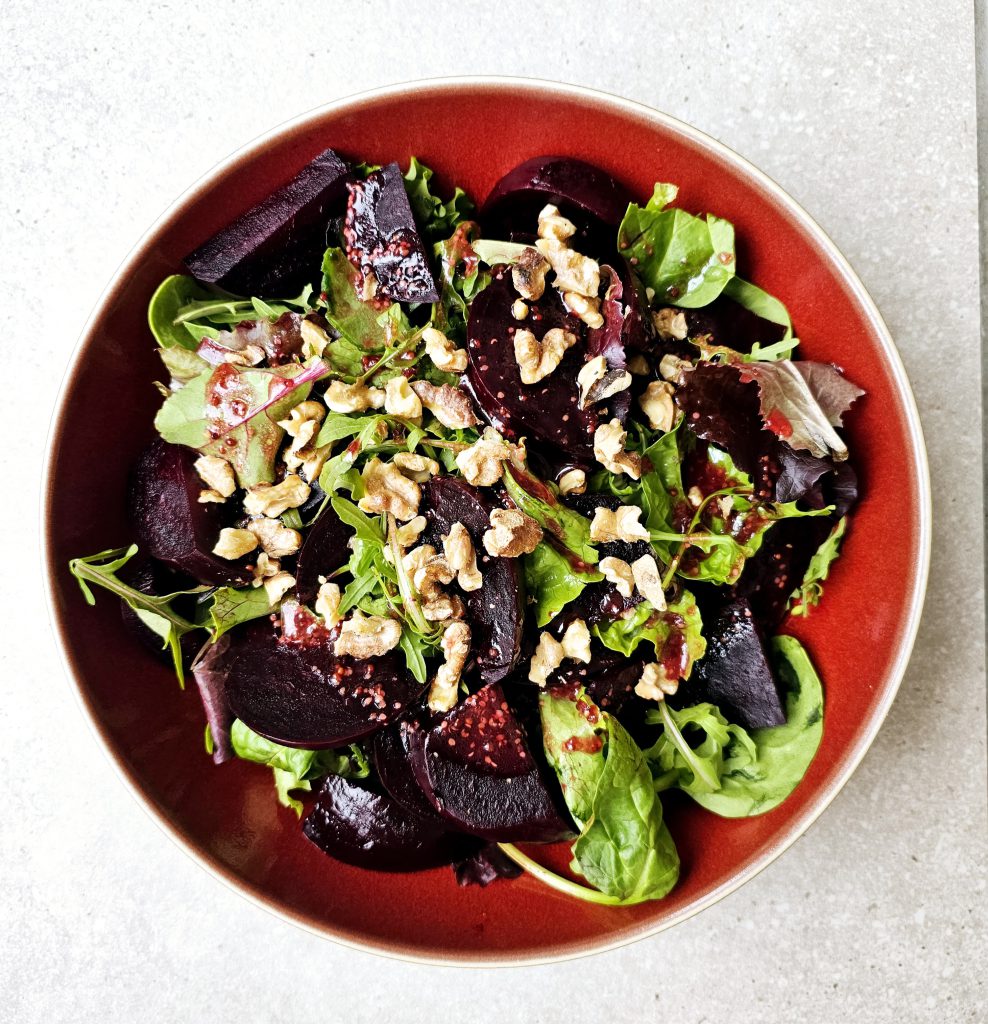

Vegetables: 4 medium sized beetroots, a handful of mixed salad leaves
Dressing: 2 tablespoons olive oil, 2 tablespoons sherry vinegar, 1 teaspoons honey, 1 teaspoon wholegrain mustard
Garnish: toasted walnuts
How To:
Preheat the oven to 180C fan.
Clean the beetroots if they look muddy. Wrap each beetroot in a piece of foil and place in a small roasting tin.
Roast for 40 minutes or until the beetroots feel soft enough for a knife to pierce through it without much resistance.
Cool the beetroots then scrape off the skin with a small knife.
Slice each beetroot in half, then each half into even sized wedges (as thin or as thick as you like).
Place the salad leaves in a serving bowl, add the sliced beetroot, whisk the dressing ingredients and pour over.
Garnish with some chopped walnuts.
Salad Number 3: Roasted Celeriac with Green Lentils and Asparagus
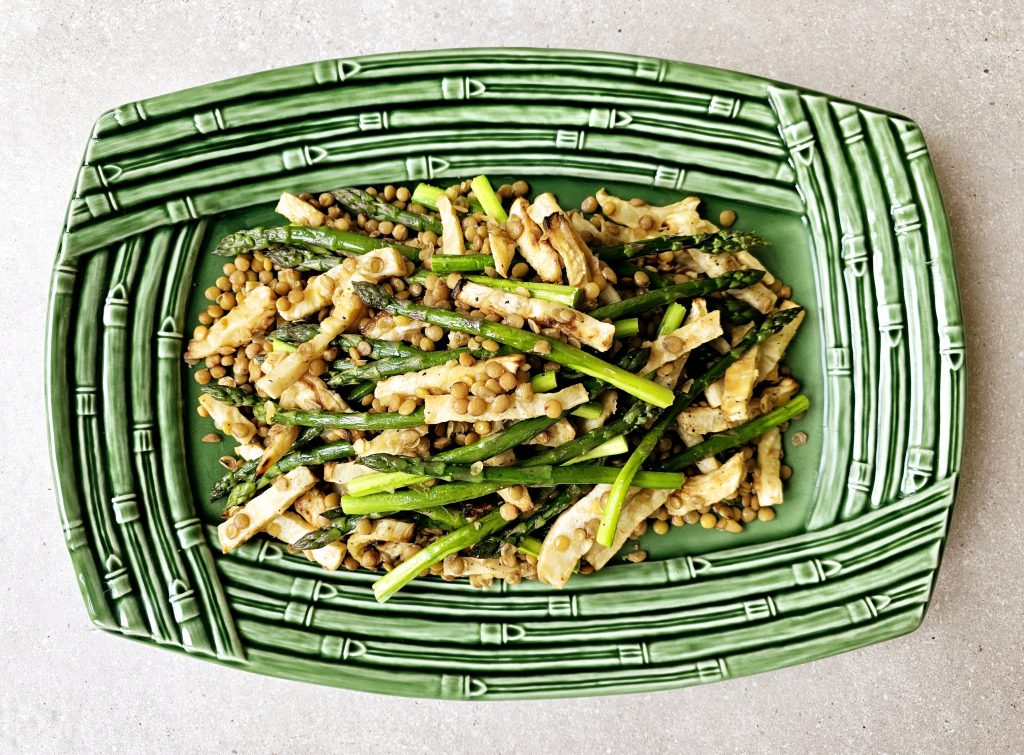
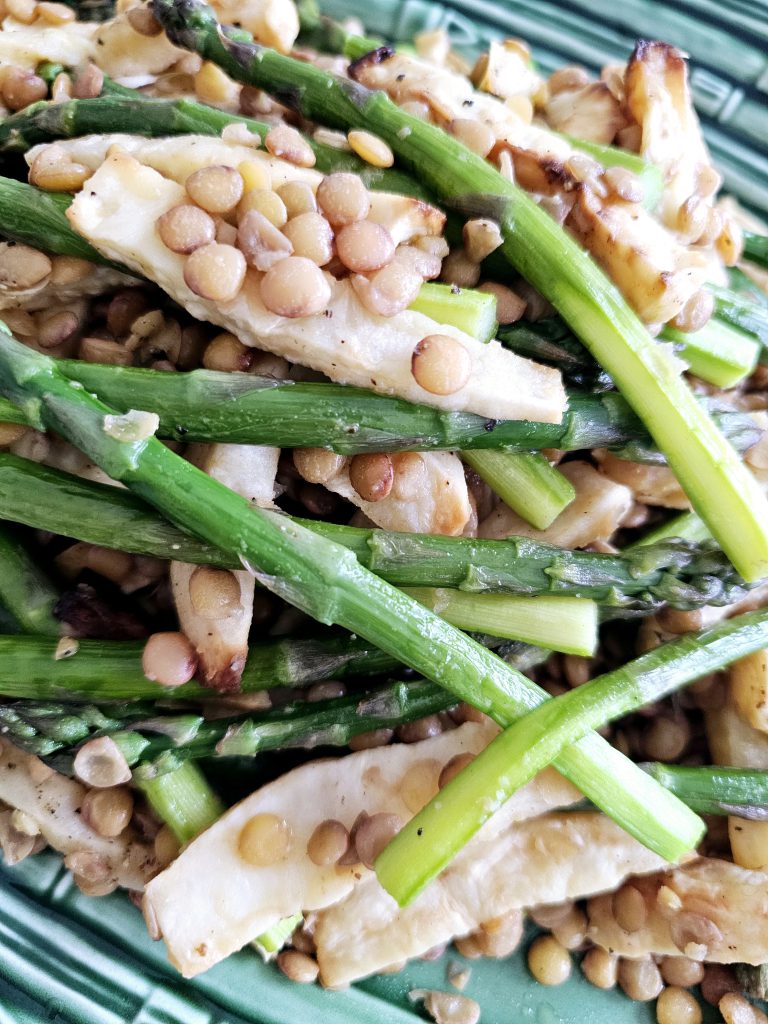
Vegetables: 550 g (peeled weight) celeriac, 150 g green lentils, 350 g thin asparagus spears, olive oil
Dressing: 3 tablespoons lemon juice, 2 tablespoons cider vinegar
Garnish: some chopped flat-leaf parsley and toasted chopped almonds would not go amiss, but this time the salad was fine without them
How To:
Preheat the oven to 180 C fan.
Please see the original recipe here, and simply add some asparagus which have been roasted at 180 C for 10 minutes. This time of the year make sure the asparagus are locally grown.
Confit Garlic and Mushroom Rice
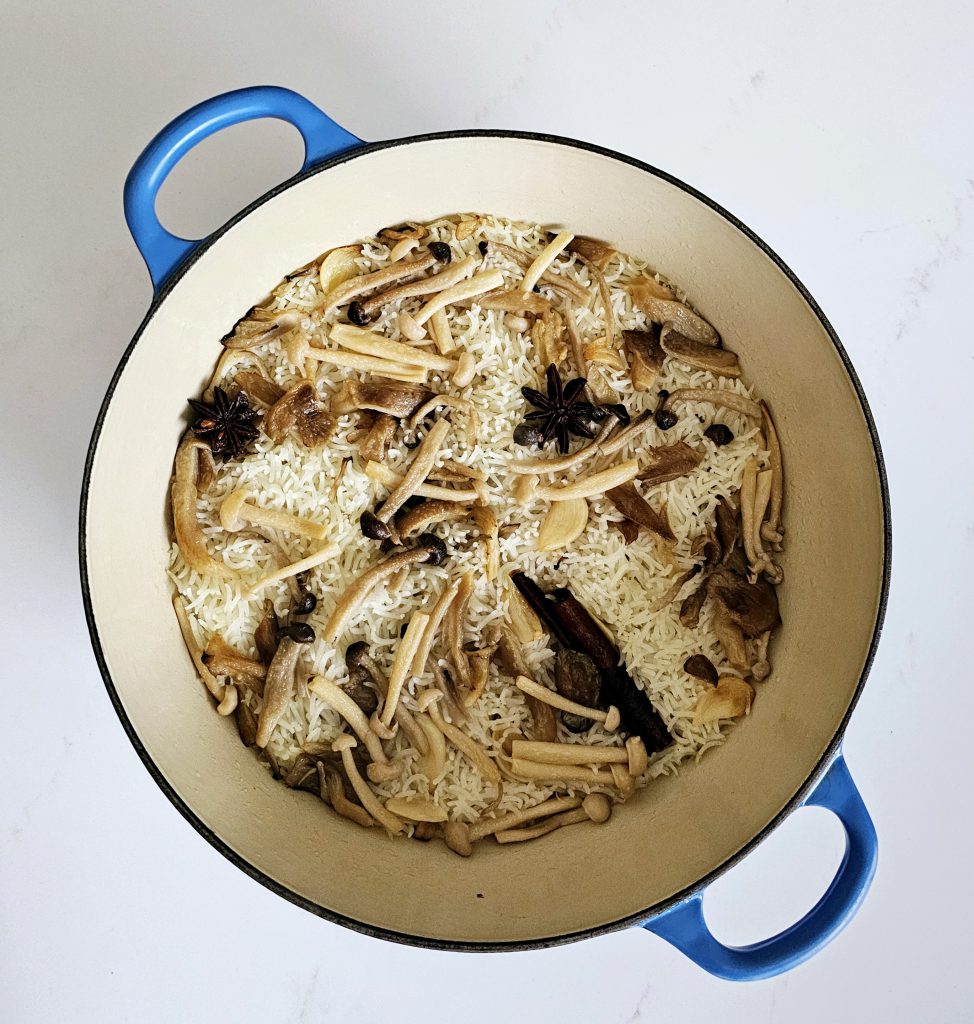
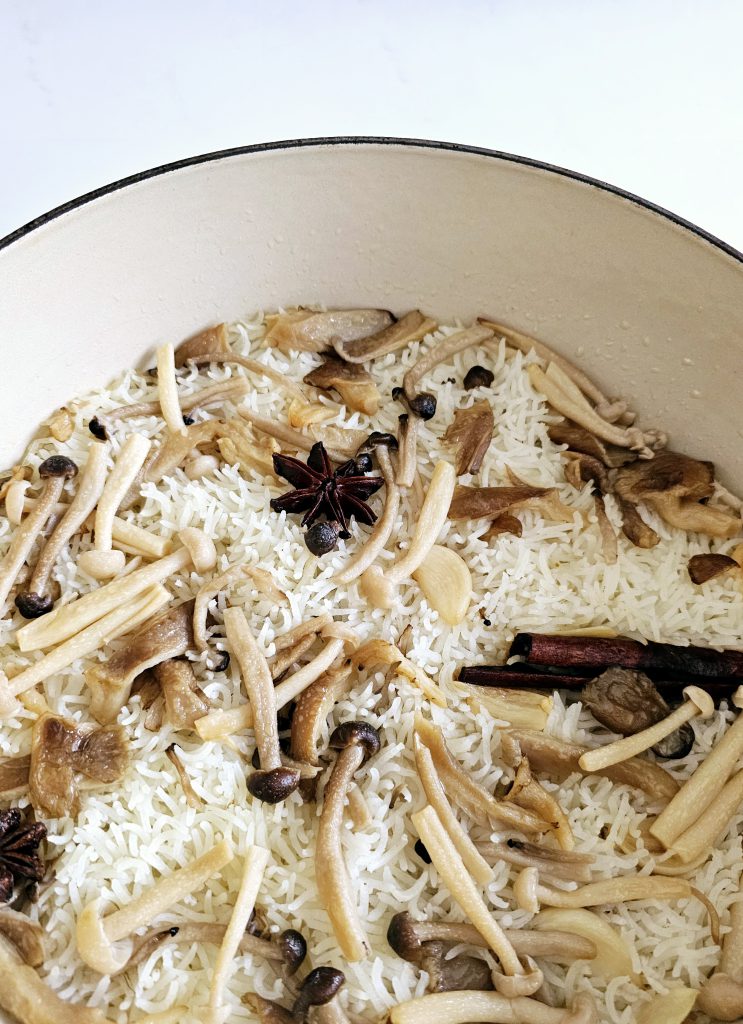
Rice: 300 g basmati rice (soaked for an hour if possible), 8 large garlic cloves, 6 tablespoons olive oil, 200 g sliced mixed mushrooms, 1 stick cinnamon, 3 whole star anise
How to:
Preheat the oven to 180C fan.
Please see the original recipe here. I make this rice a lot and today I used mushrooms. I have also added cherry tomatoes, courgette and bell peppers at other times.
Place the garlic and olive oil in a large oven-proof pot (I used Le Creuset) and cook over a low heat until softened.
Turn up the heat a little, add the mushrooms and sauté this for around 2 – 3 minutes.
Tip in the drained rice, add 600 g boiling water along with the cinnamon and star anise.
Give everything a gentle stir, cover the pot and place in the oven for around 35 minutes, until the rice is cooked.
If you have an inkling that your guests might be running late, switch the oven off after 30 minutes and leave the rice covered until everyone is ready to eat. This rice dish is very forgiving in this way.
Dessert: Pistachio Bundt

Recipe in a separate post, as it is a bit more detailed. Need I say it? I love cakes baked in bundt pans.
PS: I left out the beef curry because I had a lot to do, and used a ready made paste. But the tip is to use beef short ribs and cook this in a pressure cooker for one hour. Remove the meat from the bone, cube the meat, reduce the sauce, skim off the fat, return the meat to the sauce-turned-gravy and serve to your guests.
Gingerbread Bundt

I have been spending my free time clearing up files of unwanted notes and avoiding the still persistent rain here in London. As a reward for accomplishing more or less the daily To Do lists, I make yet another bundt cake. This time it is Nigella Lawson’s Fresh Gingerbread Cake with Lemon Icing (page 236 of How to be a Domestic Goddess). I have said it before and will say it again: baking a cake in a bundt pan makes it so much more attractive and presentable.
The original recipe will fill a 10 cup bundt pan but I wanted to make a smaller one. Much as I hate to mention this in a blog which deals a lot with baking, my doctor said I have to watch my sugar intake as my recent blood tests show that I am in the pre diabetic range. Worry about overworking my pancreas needs to balanced with a healthy eating life. I have been to hospital so many times with friends (and my father) who were dying and who wanted to eat but couldn’t. So I always tell everyone around me: eat when you can and enjoy every bite and every chew.
Each time I use my 5 cup lotus bundt pan I think of Singapore, where I bought it. Shamefully I also remember I need to write up some notes about the Botanic Gardens and share a few photos of the city at nighttime. Hopefully sometime this week or next.
The gingerbread ready to be turned out of the lotus bundt pan
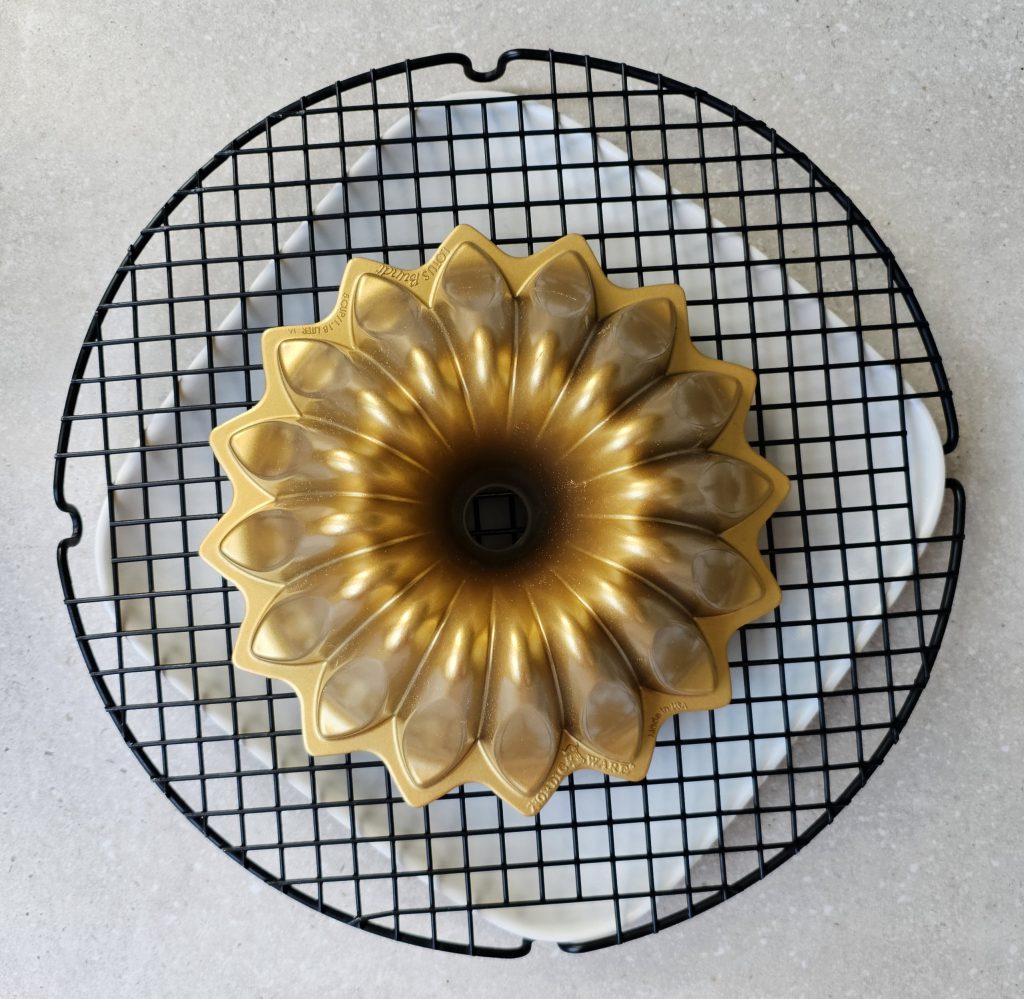
To update the recipe, I added some crystallised stem ginger, doubled the grated fresh ginger and cut the sugar elements in the cake by 60%. It was still quite sweet because of the stem ginger and the lemon icing. Instead of crystallised stem ginger it is also fine to use stem ginger that has been preserved in syrup. Either way just cut each knob of ginger into smaller pieces before adding to the cake and icing.

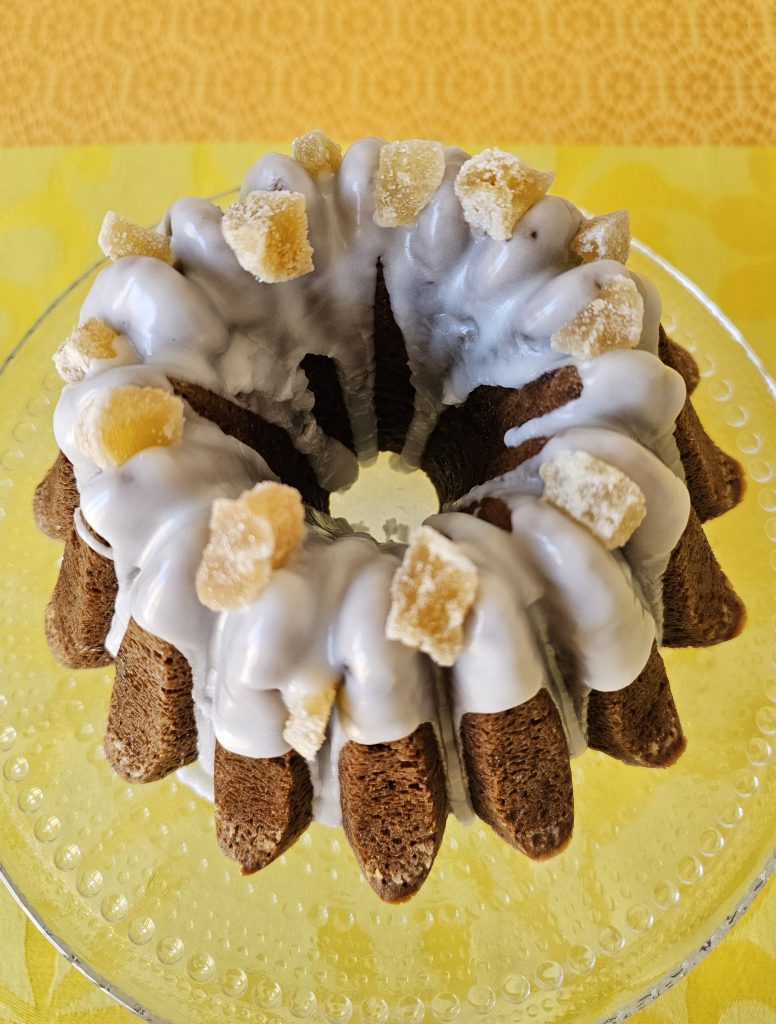
For a 5 cup Bundt (double the recipe for a 10 cup bundt):
8 g each of softened butter and plain flour, to line the bundt pan
75 g unsalted butter
25 g dark muscovado sugar
40 g golden syrup (I used Lyle’s brand)
40 g black treacle (I used Lyle’s brand)
2 teaspoons finely grated fresh ginger
½ teaspoon ground cinnamon
125 g milk (semi skimmed is fine)
1 large egg
½ teaspoon bicarbonate of soda dissolved in 1 tablespoon of warm water
150 g plain flour
85 g crystallised stem ginger (70 g for the cake and 15 g for the topping)
90 g icing sugar and 1½ tablespoons lemon juice for the lemon icing
You will also need a 5 cup bundt pan. The recipe can be doubled to fit a larger 10 cup pan. Nordic Ware is the only one manufacturer you should go to for these marvellous baking pans.
How to Make:
Preheat the oven to 170°C/ 150°C fan.
Brush the softened butter evenly over the entire inside of the pan, taking care to fill every corner. Sift over the flour, moving the pan around to coat evenly. Remove the excess flour by turning the pan upside down and giving it a tap (do this over a sink).
Start by sifting the flour into a large mixing bowl. Add 75 g of the cut up stem ginger. Set aside and prepare the wet ingredients.
Measure the milk and beat the egg into this. Dissolve the bicarbonate of soda in water. Set both of these aside.
Place the butter, sugar, golden syrup, treacle, ginger and cinnamon in a saucepan and melt together over a gentle heat. Do not boil the mixture.
Remove the pan from the heat and pour into the bowl with the flour. Add the milk and egg mixture, followed by the bicarbonate of soda in its water.
Mix everything together until you get a homogenous batter. Work fast as the bicarbonate of soda will react with the other ingredients, releasing bubbles which trap precious air into the batter.
Pour the cake mixture into prepared bundt pan. Level the surface and bake in the oven for 40 minutes (up to 55 minutes for the bigger pan) or until the cake bounces back when touched. A metal skewer inserted in the centre should come out clean.
Leave the cake to cool slightly in the pan before turning out onto a wire cooling rack to cool completely.
Make the icing by sifting the icing sugar into a bowl. Add the lemon juice then whisk until smooth.
Pour the icing over the cake and sprinkle over the remaining 15 g of stem ginger. The icing will stick better if the cake has cooled down a little.
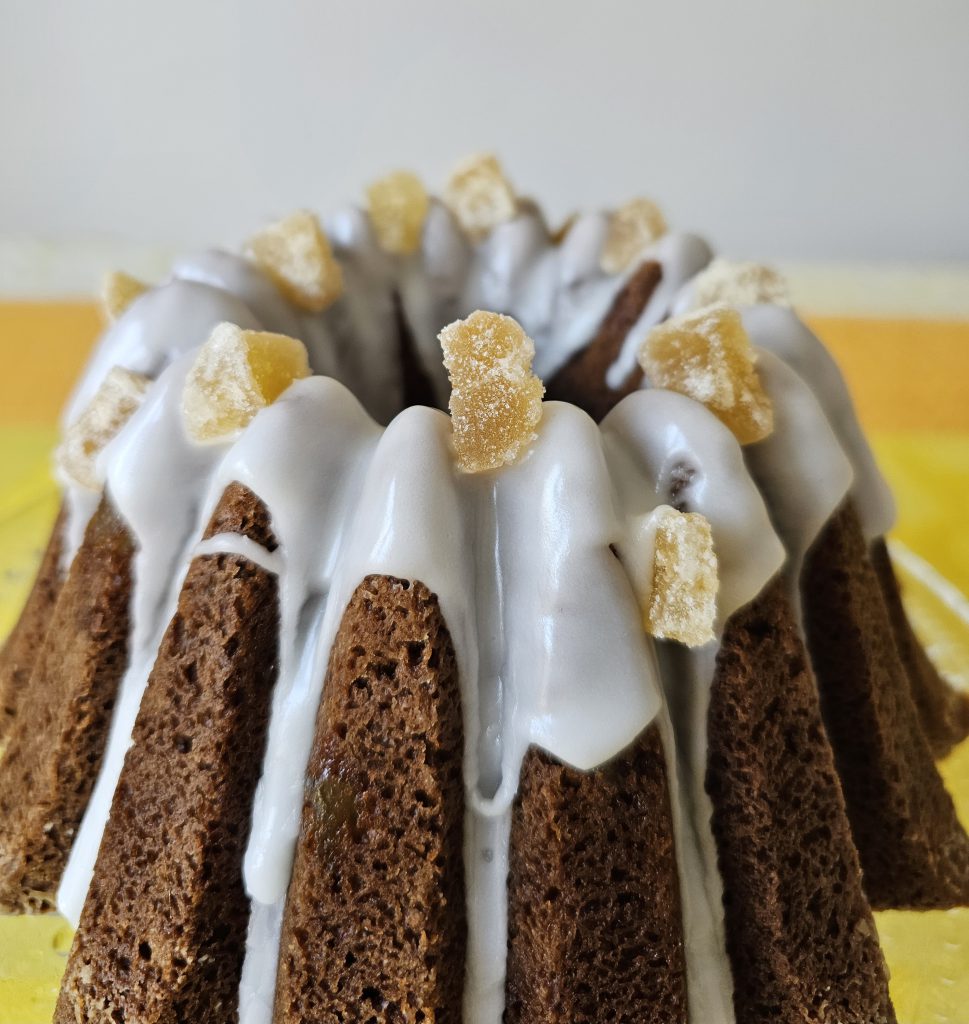
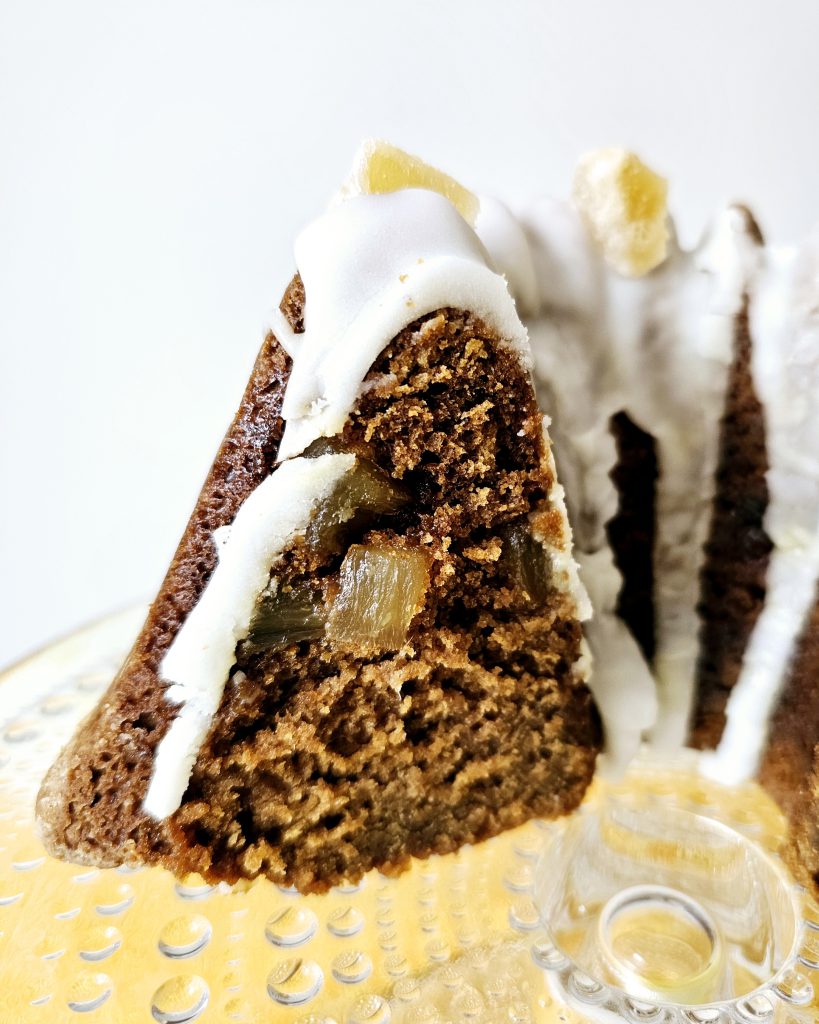
Mr Gochugaru and I loved the cake but I had a customer complaint from Junior 2. She had requested this cake as she remembered it from earlier schooldays, and so could not understand the shape, lighter colour and additional stem ginger. I had to explain that I changed the baking tin, removed 60% of the black treacle and added whole preserved ginger. She didn’t quite agree with everything but in this round of Baker vs Cake, it is the Doctor who wins hands down.
The Book:
How to be a Domestic Goddess by Nigella Lawson, published by Chatto & Windus, ISBN: 978-0701189143. You can safely cut down on the sugar in all the recipes, and still have a delicious cake at the end of the baking sessions.
Banana Bundt
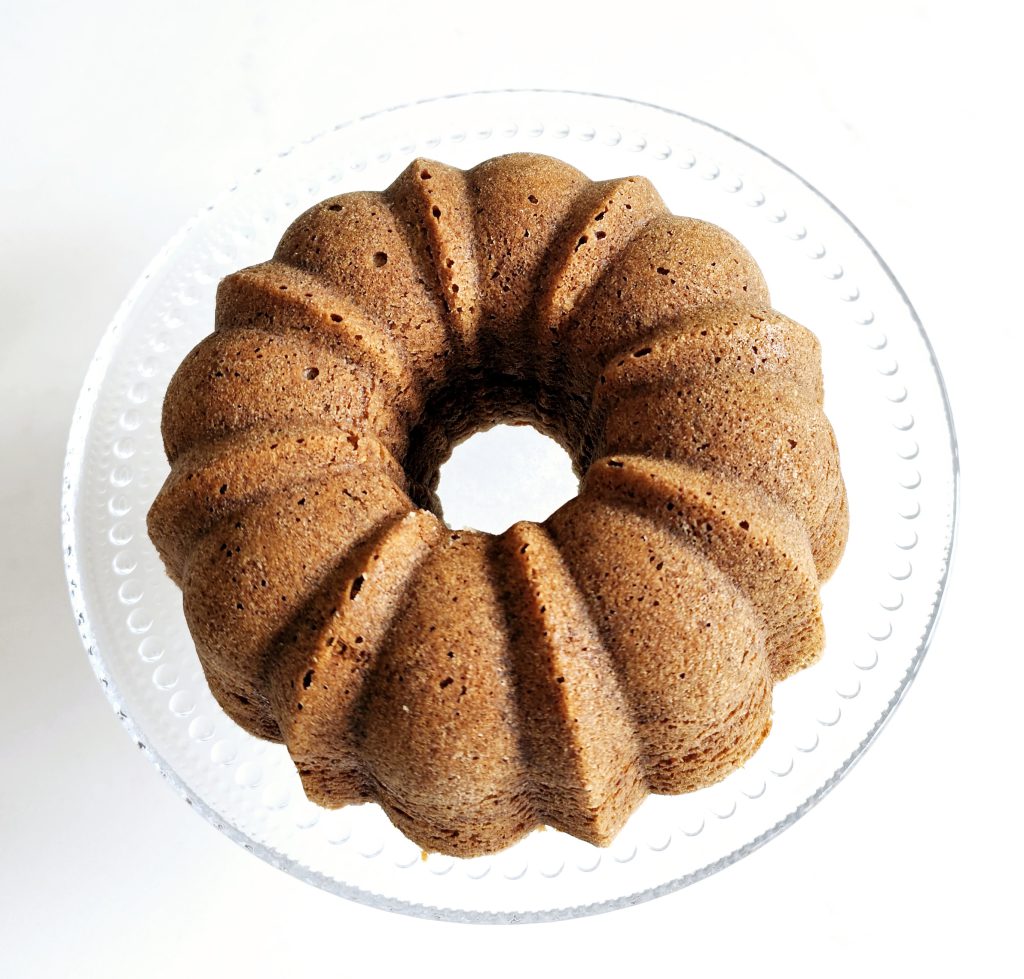
One of a number of nursery rhymes the children and I used to sing together:
Pat-a-cake, pat-a-cake, baker’s man
Bake me a cake as fast as you can
Roll it, pat it, and mark it with a B
Put it in the oven for Baby and me.
How fast can you bake a cake?
In my Home Economics classes at school, I learnt the different methods of making cake batter e.g. the creaming butter and sugar method, the whisking egg and sugar method. All add air into a batter so the cake would rise and hold its shape. I understood the science behind it, but it was also time consuming.
Imagine my surprise when I first watched Nigella Lawson putting all her cake ingredients into a food processor, giving it a whizz and pouring the batter into a baking tin. How revolutionary, and contrary to everything I had been taught previously. That Ms Lawson’s cake rose and looked very edible was the start for me to see how far I can push things when pressed for time.
There is only so much you can adapt. Definitely, you cannot make a chiffon cake unless you are prepared to wait whilst the egg whites get whipped up separately. For other simpler cakes (what I call butter, eggs, sugar and flour cakes) you can pretty much use a food processor to make the batter without compromising on the quality.
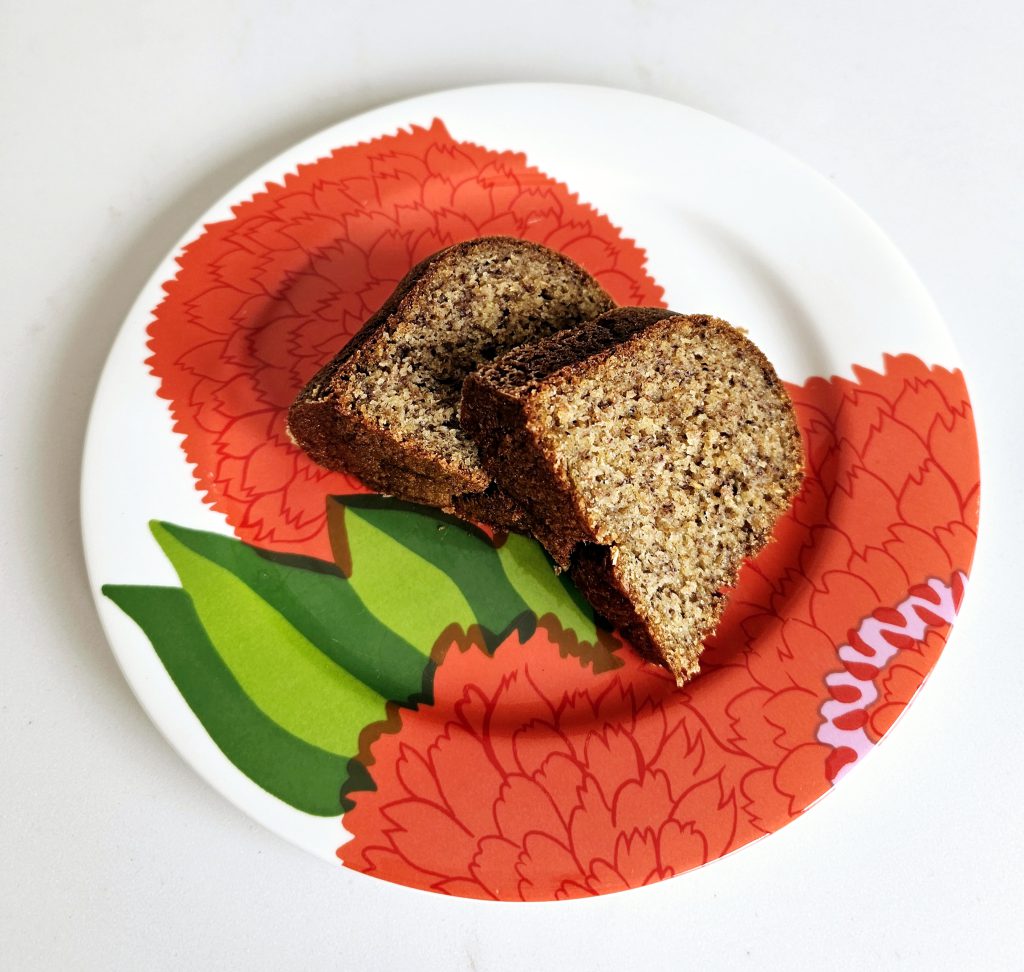
In the past few weeks I have been making batch after batch of banana cake, using different methods. I wanted something that was easy to make, looked presentable and which could also have add-ons like seeds, nuts and chocolate. I also wanted a gluten-free version for my mother-in-law.
The recipe here is what I made today, using spelt flour to up the fibre content of the cake. There is a substitution and add-ons list at the bottom of this page for ideas on how to make this cake your own.
I have always made my cakes in loaf tins or round tins. Currently I am in a bundt pan phase as their shapes make the plain cakes look so much more appealing. Here then is a banana bread recipe adapted for use in one of these shaped pans.
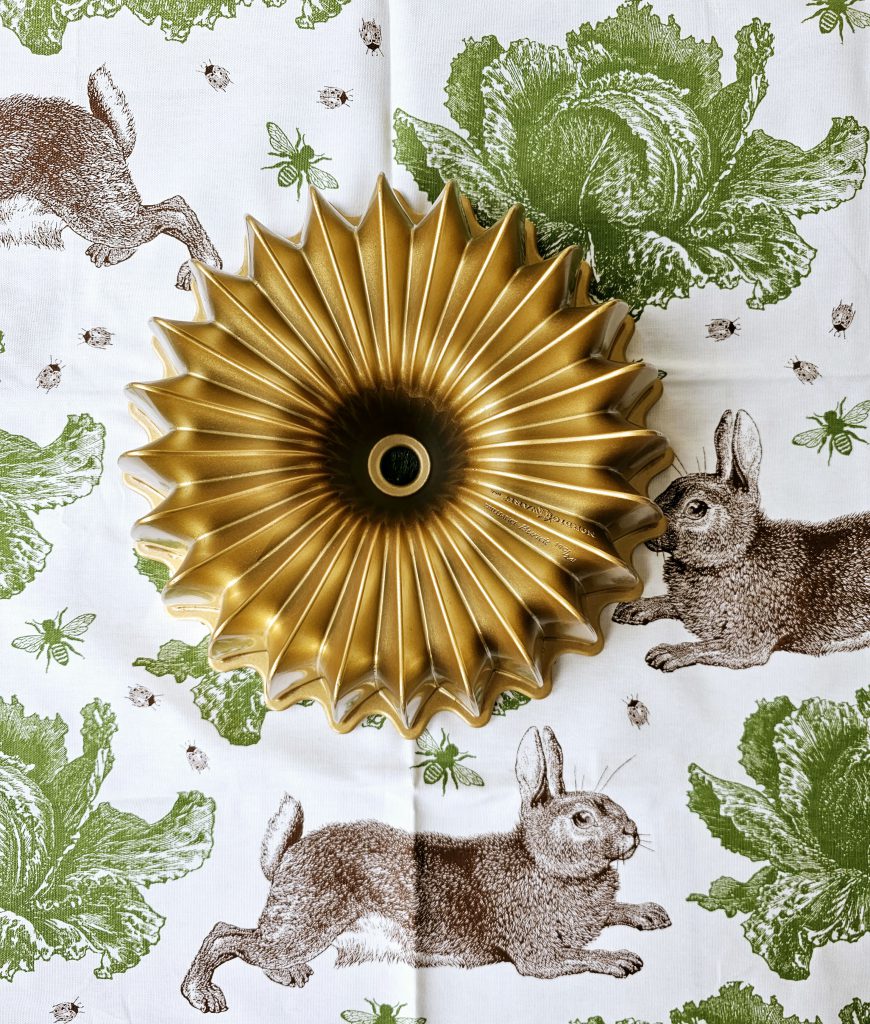

For a 6 cup bundt (see below for a 10 cup bundt)
80 g unsalted butter, very soft
80 g unrefined caster sugar
2 medium eggs (100 g without shell)
210 g ripe bananas, each cut into 4 pieces
135 g spelt flour
1¼ teaspoons baking powder
¾ teaspoon bicarbonate of soda
¼ teaspoon fine sea salt
60 g soured cream
1½ teaspoons vanilla extract
You will also need a 6 cup bundt pan. The recipe can be increased proportionately to fit a larger 10 cup pan. I used a Thermomix but you can also use a food processor. The results would be the same.
How to Make:
Preheat the oven to 170°C/ 150°C fan.
Brush 10 g of softened butter (15 g for the 10 cup bundt pan) evenly over the entire inside of the pan, taking care to fill every corner. Sift over some plain flour, moving the pan around to coat evenly. Remove the excess flour by turning the pan upside down and giving it a tap (do this over a sink).
Place the butter, sugar, eggs, banana, flour, baking powder, bicarbonate of soda, salt, soured cream and vanilla extract into the TM bowl. Mix 20 seconds/ speed 5. That’s how fast it is.
Pour the batter into the bundt pan and bake for 50 minutes (55 minutes for the 10 cup bundt) or until the cake bounces back when touched. A metal skewer inserted in the centre should come out clean.
Leave the cake to cool in the pan for 15 minutes, then turn out onto a wire rack to finish cooling. Today we ate the cake warm, after a sandwich lunch. Last week we brought a few slices (walnut version) to the Cotswolds with us for a picnic tea.
10 cup bundt with walnuts

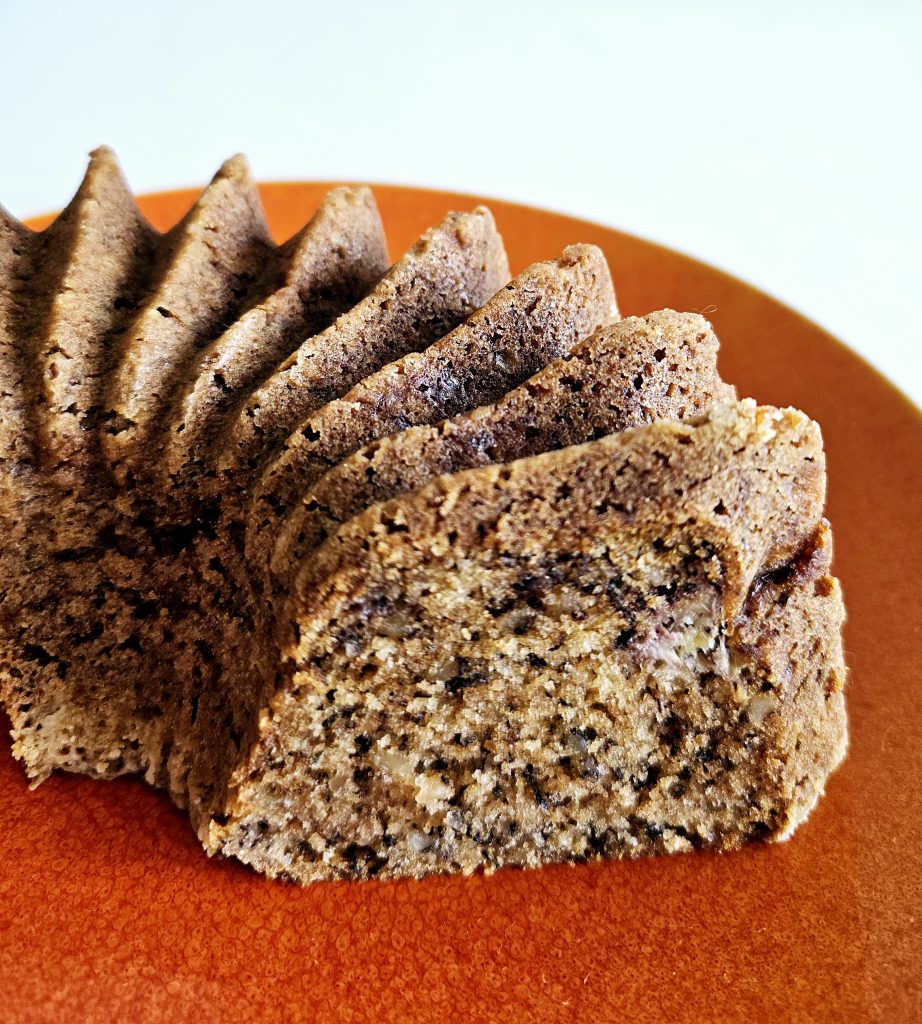
For a 10 cup bundt:
135 g unsalted butter, very soft
135 g unrefined caster sugar
3 large eggs (165 g without shell)
350 g ripe bananas, each cut into 4 pieces
225 g spelt flour
2 teaspoons baking powder
1 teaspoon bicarbonate of soda
½ teaspoon fine sea salt
100 g soured cream
2 teaspoons vanilla extract
Gluten-free version, which turned out to be the most popular on account of its sponge-like texture
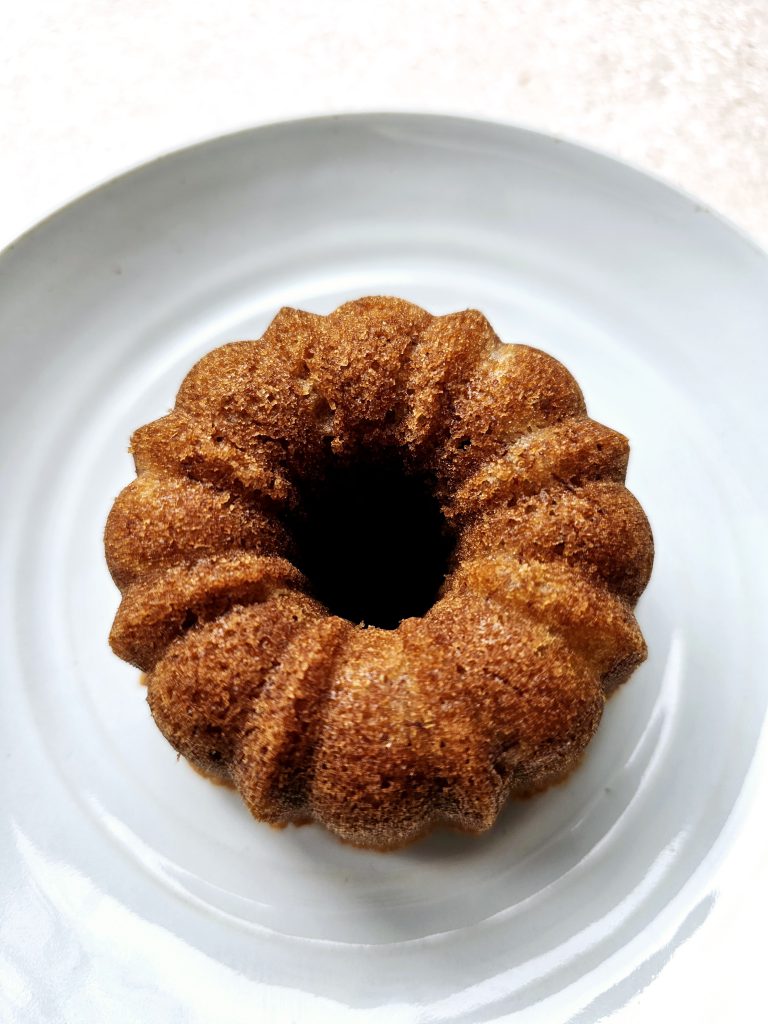
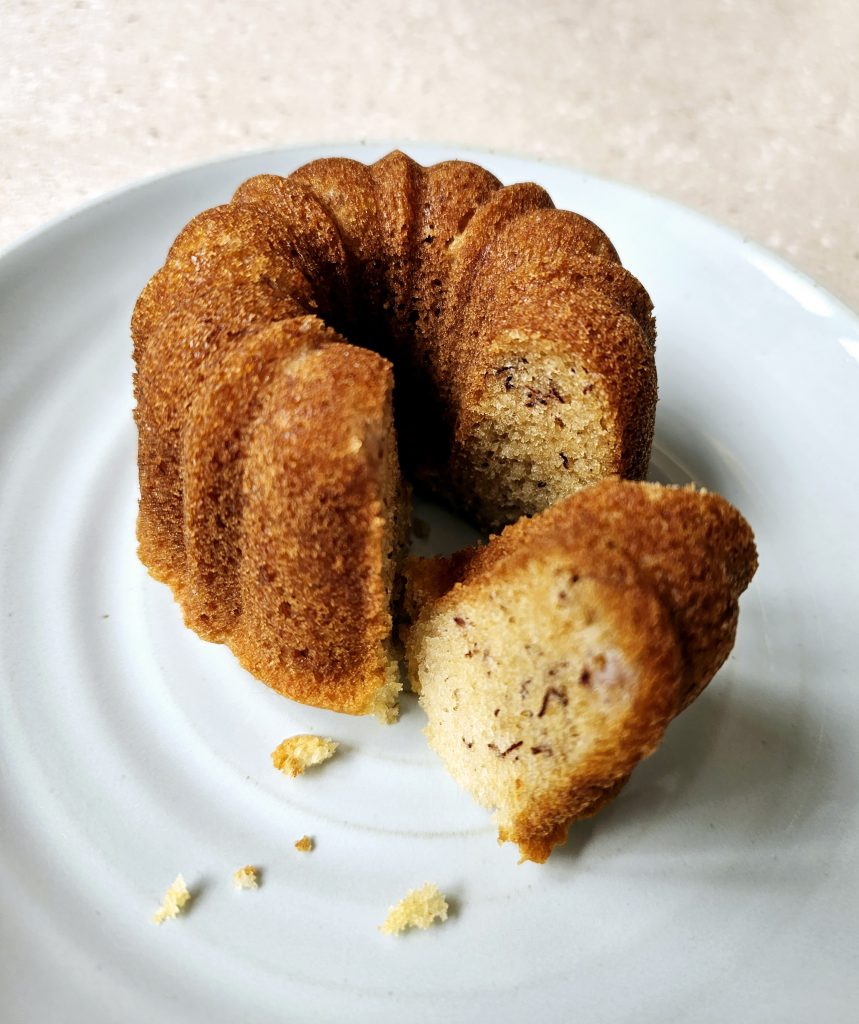
Substitutions and Add Ons
Instead of:
- spelt flour, use plain white flour, gluten-free plain flour, wholemeal flour
- soured cream, use buttermilk, plain yogurt, crème fraiche
- unrefined caster sugar, use coconut sugar, light brown soft sugar, light muscovado sugar
- butter, use sunflower oil.
For the 6 cup bundt, add one of the following:
- 50 g chopped walnuts or chopped hazelnuts (works best with plain flour)
- 2 tablespoons poppy seeds
- 60 g milk/ dark chocolate chips.
For the 10 cup bundt, add one of the following:
- 80 g chopped walnuts or chopped hazelnuts (works best with plain flour)
- 3 tablespoons poppy seeds
- 100 g milk/ dark chocolate chips.
For the gluten-free version I used flour and raising agents from Freee. Here is a gluten-free banana bread recipe from Nigella Lawson
